A Descriptive Study of Howard Goldblatt’s Translation of Red Sorghum With Reference to Translational Norms
Lauren Gibello & Harold Lesch
Stellenbosch University, South Africa
A Descriptive Study of Howard Goldblatt’s Translation of Red Sorghum With Reference to Translational Norms
Lauren Gibello & Harold Lesch
Stellenbosch University, South Africa
This research seeks to provide a descriptive study of the English translation of the breakthrough Chinese novelRed Sorghumby Mo Yan. The novel is a prime example for the research into strategies and norms in translation within a Chinese-English framework for three main reasons. Firstly, due to the huge impact the novel has had in terms of its truth-telling about the Sino-Japanese War (1937 – 1945) in China. Secondly, because of Mo Yan’s unique non-linear writing style, and thirdly for the fact that the novel was translated by Howard Goldblatt, who is an American native English speaker, which is fairly rare in terms of Chinese-English translations.
This research seeks not only to provide a descriptive study of Howard Goldblatt’s English translation of the breakthrough Chinese novel but also to explore the strategies he employs during the translation process. An investigation is carried out to determine whether Goldblatt makes use of particular translation strategies and follows these approaches throughout the novel, thereby creating certain translational norms. Through primary research into the novel one would find that this is in fact the case. For example, he makes use of a domesticating approach in terms of translating Chinese cultural items, phrases, or terms. However, it is only through more in-depth research and a close comparison of the source and target texts, that one finds that Goldblatt does not in fact follow similar strategies in every instance but uses them sporadically throughout the novel according to the context or message that must be carried across. These discoveries are significant in that they are not entirely what is expected nor what is initially found by other scholars.
Finally, the results of this research along with the descriptive study of the translation ofRed Sorghumand the investigations into the translation strategies and norms at play during the translation process allow for better understanding of the translation process. Furthermore, the results show evidence that strategies can be used interchangeably toproduce satisfactory translations such as that of Goldblatt’s English translation of the novelRed Sorghum.
English translation, norms,Red Sorghum, Howard Goldblatt, Mo Yan
Introduction
Red Sorghum, which was a breakthrough novel in China, was translated for the English target readership by a very well-known American translator, Howard Goldbatt. This research provides a descriptive study of the novel through delving into the translation strategies, decisions, and norms at play during the process of translation.
The investigation and research into this novel are important due to several aspects. Firstly, the novel is set during the Sino-Japanese War (1937 – 1945) which resulted in a very historically and culturally based novel. Secondly, Mo Yan’s writing style is unique in that he uses colloquial Chinese dialects throughout the novel and writes in a nonchronological order, moving back and forth in time, thereby creating a complex but interesting read. Thirdly, the novel is pioneering in that it was translated by an American native English speaker, who has little personal connection with Chinese history and culture. The combination of these factors allows the research into this novel to be significant and its findings of vital importance.
The purpose of this research is to provide translators and experts in the field of translation with a better understanding of the translation process. The research problem is to determine the translation strategies, decisions, and norms at play during the translation process, thereby providing a descriptive study of the English translation ofRed Sorghum. Through this research into the translation decisions made by Goldblatt, the translation strategies he employs, and hence the translational norms at play, one is able to better understand the translation process and provide a descriptive study of a novel that is indeed paramount in the world of Chinese-English translation.
The article is structured as follows: an overview of the relevant literature with reference to translational norms; background of both the original author, Mo Yan, and of the translator, Howard Goldblatt; the writing style of the novelRed Sorghumis highlighted as well as Howard Goldblatt’s approach to translation with special reference to the translation strategies and the applicable norms; a discussion relating to the comparison of extracts of the source text (henceforth ST) and target text (henceforth TT); and finally, concluding remarks on translational norms pertaining to the novel.
Literature Review
The main focus of this section will be on translation theorists, Gideon Toury (1995) and Andrew Chesterman (1993) and their norm theories which have had a profound impacton Translation Studies. This section will also include relevant background information on other translation theorists such as Christiane Nord (2006) and Lawrence Venuti (1995) who were also influential in Translation Studies and in particular norm theory.
Norms, in a very general sense, can be defined as “general values or ideas shared by a certain community—as to what is right and wrong, adequate and inadequate” (Toury, 1980, p. 51). Translational norms are therefore the values or ideas shared by translators as to how one ought to translate or how a translation ought to be carried out. Norms in translation “provide the link between, on the one hand, the general values or ideas shared by a community as to what is right/wrong or adequate/inadequate and, on the other, the performance of translators observed in particular situations” (Palumbo, 2009, p. 179).
Translation as a socio-cultural phenomenon is subjected to several constraints and rules, one of which is the translational norms (Toury, 2000, p. 199). Norms in a general sense can “be understood as stronger, prescriptive versions of social conventions. Like conventions, norms derive their legitimacy from shared knowledge, mutual expectation and acceptance, and the fact that, on the individual level, they are largely internalized”(Hermans, 2009, p. 81).
In order to better understand the process of translation and why translators make the decisions they make, one needs to conduct in-depth research into the norms and conventions that exist in translation. It can be said that “being a translator cannot be reduced to the mere generation of utterances which would be considered ‘translations’” (Toury, 1995, p. 53) but must in fact be seen as a process which is guided by certain contraints or collective ideas which form part of the whole translation process. Translation can therefore be described as being subject to certain constraints which “extend far beyond the source text, the systemic difference between the languages and textural traditions involved in the act, or even the possibilities and limitations of the cognitive apparatus of the translator as a necessary mediator” (Toury, 1995, p. 54). Translation is therefore not only constrained by language, language differences, and problems that languages themselves present but also by these translational norms. Norms play a very important and vital role in the decision making process during translation, guiding the translator in decisions that have to be made.
Due to the important role these norms play in the translator’s decisions, norms can be seen as “the repertoire of habits, skills, and styles based on which translators adopt certain strategies instead of others. In terms of the production of translations, they act as binding guidelines, as adherence to norms is sanctioned (positively or negatively, as we have seen). In terms of the assessment of translations, norms serve as parameters or yardsticks”(Palumbo, 2009, p. 179). Translation is therefore a structured process which is guided by these norms. Research into these norms can therefore determine the way in which translators produce translations.
The idea of translating as decision-making has been around since Ji?í Levy and Itamar Even-Zohar in the 1960s. The concept of norms is however often attributed to Gideon Toury, who was the first to introduce his tripartite model of norms into translation theoryin the 1970s (Pym, et al., 2008). Since the 1970s, many other theorists have built on and refined Gideon Toury’s norm theory and hence the concept of norms has evolved and changed.
The concept of norms was initially introduced into translation studies “in an effort to explain why translators regularly make certain choices rather than others” (Riccardi, 2002, p. 14), therefore creating a certain expectation as to what could be considered a translation and what would not be considered a translation. Furthermore, “norms make actions and choices more predictable throughout a community or parts thereof and thus help to circumscribe and regulate the field of translation” (Riccardi, 2002, p. 16). These norms and conventions also govern the social and cultural discipline of translation (He, 2005). In summary, norms therefore serve two main purposes; they regulate and organize the translation process and they govern the translation and the decisions made by the translator.
Gideon Toury, along with many other translation theorists, regards translation as a norm-governed activity (Toury, 1995). “If translating as a communicative and therefore social activity is norm-governed, it follows that the entire operation of translation is filtered through the values which norms secure” (Riccardi, 2002, p. 16), making it once again evident that norms are important for the role a translator plays in the translation process.
Furthermore, “the notion of norms assumes that the translator is essentially engaged in a decision-making process” (Baker & Saldanha, 2008, p. 190), giving the translator a more active role in translation decisions. The translator is seen as having a choice to make as to whether he will follow the norms, or decide against following them. The choice to follow certain norms or not is therefore solely the choice of the translator, which places a large degree of responsibility on the translator. Norms “operate at the intermediate level between competence and performance, where competence stands for the set of options translators have at their disposal and performance refers to the options actually selected”(Hermans, 2009, p. 75). Competence can therefore be a list of the options a translator can choose from and performance the set of choices the translator actually decides to make (Baker & Saldanha, 2008, p. 190).
It is therefore also evident that “acquiring a set of norms for determining what is appropriate translational behaviour in a given community is a prerequisite for becoming a translator within that community” (Baker & Saldanha, 2008, p. 190). Therefore, one can say that norms are specific to a certain language community or group and are absolutely vital to the translation profession. Furthermore, norms affect many different aspects of the very complex translation process and therefore require the need for practical research and investigation.
In many ways, Andrew Chesterman’s norm theory is similar to that of Gideon Toury’s. Chesterman and Toury both see norms as descriptive and not prescriptive. Chesterman“considers the way in which norms and even ‘normative laws’ appear to operate in the world of translation, without necessarily wishing to recommend or impose them”(Hermans, 2009, p. 77). Although Toury and Chesterman’s norm theories are similar when compared closely, “Chesterman looks at norms from a broader perspective, taking into account not only process norms (as in Toury) but also product norms, as to obtain a wider picture of the constraints operating on the practice and reception of translation” (Palumbo, 2009, p. 148). Chesterman’s norm theory is also considered an improvement on the original theory set out by Toury. “Chesterman’s product and process norms correspond to Nord’s constitutive and regulative conventions, they are a clear advance on Toury’s list”(Hermans, 2009, p. 79).
Gideon Toury is often associated with the concept of norms, due to the fact that he was the pioneer in introducing this concept into Translation Studies. The work of Ji?í Levy and Itamar Even-Zohar in the Polysystem theory paved the way for Toury’s norm theory in translation and the emergence of Toury’s Descriptive Translation Studies or DTS (Baker & Saldanha, 2008, p. 190), which also resulted in the introduction of his theory of norms into Translation Studies (Pym, et al., 2008).
Gideon Toury “saw norms as performance instructions for translators and distinguished different kinds of norms operating at different stages of the translation process” (Hermans, 2013, p. 3). Toury (1995) discusses a three-dimensional approach to the process of translation in his book titledDescriptive Translation Studies and Beyond, which consists of preliminary norms, initial norms, and operational norms.
Lawrence Venuti (1995) introduced two translation strategies, namely foreignisation and domestication, in his book titledThe Translator’s Invisibility: A History of Translation. Foreignisation, according to Venuti (1995, p. 20), is “an ethno deviant pressure on those (cultural) values to register the linguistic and cultural difference of the foreign text, sending the reader abroad”. Foreignisation “refers to a translation strategy aimed at rendering the ST conspicuous in the target text or, in other words, at avoiding the fluency that would mask its being a translation (which can be seen as the result of the opposite strategy of domestication)” (Palumbo, 2009, p. 48). Foreignisation’s main focus is on literal translation. Foreignisation would therefore mean that the translator leaves foreign words or concepts in the translation of the target text in order for the reader to feel like he is reading a foreign text, therefore clearly indicating that the text has been translated.
Domestication on the other hand is “an ethnocentric reduction of the foreign text to target-language cultural values, bringing the author back home” (Venuti, 1995, p. 20). Domestication “is a global strategy of translation aimed at producing a transparent, fluent style in the TL” (Palumbo, 2009, p. 38). In terms of a domesticating approach, a translator finds equivalents of foreign terms in the text to allow the reader to feel as though the text were originally written in the target language.
These two strategies are closely linked to the terms of acceptability and adequacy, which Toury uses to refer to the approach a translator takes in following norms of the source text or creating norms that exist in the target language and culture. These two concepts should not be seen as mutually exclusive but can be used interchangeably.
In order to explain why a translation looks the way it does, one needs to ask the question: “Why did the translator translate in that manner?” The answers to these kinds of questions include “because he adhered to certain norms, because he had a certain conception, interpretation of the source text” (Riccardi, 2002, p. 34). This can then be furthered by more research and questioning into norms, such as the question which is posed quite often, “to what particular norms did the translator adhere, or what was the translational interpretation in this particular case?” (Riccardi, 2002, p. 34).
However, these questions can be ignored in the same manner that norms can be ignored and not adhered to in many cases. Some translators believe that norms restrain innovation and creative thinking (He, 2005) and therefore decide not to adhere to them. Failing to apply certain norms or adhere to certain norms however is not always considered a negative action; it can be considered part of a translator’s creativity (He, 2005). Furthermore, Chesterman argues that “norm-breaking may be deliberate, to enhance the function of the translation” (Chesterman, 1993, p. 3). For example, it may go against norms to veer from the source text, but the translation may require that you do in fact move away from the source text in order to create a suitable translation. Furthermore, some “l(fā)iterary translators might claim that their intention is precisely to break these norms. And translations of advertisements sometimes appear deliberately to flout the expectancy norms of the target culture” (Chesterman, 1997, p. 60).
When investigating norms in an existing translation, a translator must look at certain aspects of the translation. Norms in translation “can be discovered by looking at two kinds of material: primary texts (in this case translations), to see what translators have actually done, and secondary (theoretical or critical) statements about what translators should be doing, what they want to do, or what they want to be seen to be doing” (Pym, 1998, p. 111). Translational norms are “responsible for the field of translation making any sense at all, even to the point where any norm is better than none” (Pym, 1998, pp. 110-111). Furthermore, He (2005, p. 56) argues that the translation product “is directly shaped by the translator’s comprehension of the source texts and the specific strategies he employs”. With two very varied languages, such as Chinese and English, each following their own grammar and writing system, one can argue that Howard Goldblatt’s intervention in rewritings and additions is inevitable in the translation of this novel (He, 2005).
Having noted the different translation theories, it is important however to keep in mind that these norms are not in any way prescribed rules that onemustfollow. In fact, many theorists including Chesterman and Toury prefer to see norms as being descriptive rather than prescriptive (Pei, 2010, p. 29). “[N]orms are neither true nor false, for they do not represent assertions. Rather, they stipulate what ought to happen, how things should be” (Hermans, 2009, p. 84). Therefore, norms, in every instance, should not be seen as set rules that must be followed but rather as constraints that a translator either chooses to adhere to or not.
Background: Red Sorghum
Red Sorghumwas the second of Mo Yan’s novels to be published and his first American publication. The Chinese novel was originally published under the nameRed Sorghum Clan.1Many of the translations retained the word ‘clan’ in the translated title, with the exception of the English translation which was simply calledRed Sorghum. The complete novel contains five volumes,Red Sorghum(which was originally published on its own) and additional four volumes which are titledSorghum Wine,Dog Ways,Sorghum Funeral, andStrange Death.
Red Sorghum, which became widely known as a post-Mao breakthrough novel (Goldblatt, 2009), was written by Mo Yan during his time at the People’s Liberation Army (PLA) college (Mo & Lin, 2006).Red Sorghumwas not only a breakthrough novel in terms of the excellent imagery and approach to writing but also due to the fact that it broke down boundaries like no other Chinese novel had ever done before. It broke down boundaries in terms of “sexual libertinism and truth-telling about the war with Japan” (Link, 2012, p. 6) while at the same time creating an interesting plot. Furthermore, in terms of its translation,Red Sorghumis described as a “challenging and brilliant novel [which] is one of the most important doors that has been opened for Westerners to gain a glimpse of Chinese history and culture as a robust alternative to projecting Western values and identities on the East” (Davis-Undiano, 2012, p. 5). By giving Western readers the opportunity to read stories about a period in China that many Westerners were not aware of, it has created many new talking points and bridged huge gaps between the West and China. Mo Yan’s “difficult and challenging vision […] opens a door for Western engagement with Chinese culture as few others have done” (Davis-Undiano, 2012, p. 5).
The novel was first published in China in 1986 and later translated and published for the Western audience in 1993. This story is “a historical romance with bold and unrestrained erotic imagery, [which] propelled Mo Yan’s writing into a new creative vista”(Wang, 2000, p. 487). “On the surface,Red Sorghumseems to be about the war against Japan. But in reality, it’s about the folklore and legends […]. Of course, it’s also about [the] […] longing for the contentment of love and a life of freedom” (Mo, 2010, p. 226). The novel is therefore much more than just the truth-telling of trying times in China’s history but a novel filled with stories of legends, love, and freedom, and one that could not go unpublished.
The concept of red sorghum, a kind of wheat, is central to the novel as a metaphor for change and loss. “Each culture has its own equivalent of red sorghum—a Palestinian olive tree, a Canadian maple, a cotton bush in the American deep South” (Walter, 1993, p. 1). In the novel one finds “explicit connections in the novel between blood, flesh, and the sorghum fields, sustenance, and wine making, all situated around sorghum fields as a source of vitality and a staging for death. The connectedness to the sorghum fields in the novel is so pervasive as possibly to go unseen” (Davis-Undiano, 2012, p. 4). Sorghumis a kind of wheat which had been “used as food and as an ingredient of a potent wine, [it] had been the focus and metaphor of peasant life during peacetime. In wartime, it becomes intertwined with the struggle for life” (Avery, 2014, p. 6). The idea of sorghum is therefore central to the novel and hence aptly chosen as the novel’s title.
In terms of Mo Yan’s literary style,Red Sorghumis not written in chronological order but rather moves back and forth with the reader making connections between the different events (Inge, 2000). Mo Yan’s novels are unique in this way. “For writers like Mo Yan, and so many of his contemporaries, history is neither circular nor linear but random and shifting, until the boundaries between past and present blur into obscurity” (Weston & Jensen, 2000, p. 330).
Background: Mo Yan
Mo Yan is one of China’s most renowned literary writers, andRed Sorghumis his best known novel. Born as Guan Moye in China, in 1955 (Mo & Lin, 2006), hisnom de plumeMo Yan translates into English as ‘do not speak’. This name was given to him by his parents at a young age as advice during the Mao era in an attempt to get him to refrain from speaking his mind while outdoors, due to China’s very unstable revolutionary situation in the 1950s (Link, 2012). Although he is described as a man of few words in public, his vivid, extremely expressive (Hewitt, 2012) writing tells a very different story.
What sets Mo Yan apart from other Chinese authors is the fact that he writes powerful, visual, and at times absurd stories about China and its people. His writing does not hold back, breaking boundaries that no other writer dared to approach before. In China, writing and especially literary writing is governed by many Chinese laws and one cannot simply write as they please. Many Chinese writers were, and still are, fearful of being punished for what they write on sensitive Chinese historical or cultural topics. “Over the past 25 years, Mo Yan […] has been writing brutally vibrant stories about rural life in China that flout official Communist Party ideology and celebrate individualism. He also flouts literary conformity, spiking his earthy realism with fantasy and hallucination” (Moore, 2012, p. 1). He goes beyond the boundaries that other Chinese writers seem to stick very closely by. When it comes to writing, Mo Yan does not fear taking a path that is perhaps less travelled, making him stand out from the crowd.
Mo Yan’s writing is magical in description, and horrific in detail. Mo Yan’s translator Howard Goldblatt describes the writer’s work as “bawdy when he wants to be. Big and bold, lots of adjectives, and long sentences. […] When he describes a scene, he does it with every tool in his box. He turns things on their head and makes them be something they could never be in real life. In Mo Yan’s hands, even the most horrific scenes have a great beauty to them” (Moore, 2012, p. 1). Goldblatt describes him “as a quiet and thoughtful autodidact” (Moore, 2012, p. 1). He also speaks very fondly of the Chinese writer who claims he still has at least 300 old stories to tell in the form of novels one day(Hewitt, 2012).
The translation of Mo Yan’s novelRed Sorghum, along with many of his other works, allowed the West and Western readers the chance to experience Chinese history and culture in a completely new way. “Western active appreciation of Mo Yan signals a Western openness to Chinese literature and a deepening engagement with Chinese culture” (Davis-Undiano, 2012, p. 1). This novel is therefore not only a brilliant read but creates an intercultural communication link between China and the West, bridging a gap that is vast and allowing a completely new understanding of Chinese culture for the Western world.
Background: Howard Goldblatt
Howard Goldblatt is often described as ‘prolific and influential’ (Post, 2014) and ‘modern Chinese literature’s greatest translator’ (Levitt, 2013), and could therefore be considered a pioneer translator for Chinese-English literature. Being the sole translator of Mo Yan’s novels as well as several other Chinese-English translations, he has definitely made a name for himself in the profession as an excellent translator. The task of translating Mo Yan’s novels is not at all an easy one, even less so for someone who is not Chinese.
Goldblatt began his career in translation by translating Xiao Hong, a female writer from China, and later contemporary authors like Chine Jo-hsi and Zhang Jie (Levitt, 2013). However, Goldblatt’s interest in Mo Yan began many years later. He first heard of the writer in 1988 when his friend had sent him a copy of the Hong Kong literary magazine which containedThe Garlic Balladsby Mo Yan. Following what Goldblatt described as ‘a(chǎn) powerful read’ he wrote to Mo Yan offering to be his English translator (Levitt, 2013).
As Mo Yan’s sole English translator, Goldblatt has allowed the English-speaking world a view into Chinese literature, culture, history, and the brilliant literary writings of Mo Yan. Howard Goldblatt is now a well-known American literary translator of several Chinese novels. Mo Yan’sRed Sorghum,The Republic of Wine(1992),The Garlic Ballads(1989),Shifu, You’ll Do Anything for a Laugh(2003),Big Breasts and Wide Hips(1996), andWolf Totem(2004) are just a few of the many works translated by Goldblatt (Cohorst, 2012).
His work often appears with praise, perhaps something that is quite rare for a translator. Translators who do their work well are often ‘invisible’ because a well translated text should not be detected as having been translated. It is not until they produce a work that is not well translated that they are truly seen, and in this case, it is in a negative light. “If Howard Goldblatt is doing his job well, no one realizes that he’s doing it at all” (Levitt, 2013, p. 1). However, his work still appears in media publications in a very favourable light. His work has been displayed on the front pages of many newspapers and magazines, includingThe Washington Post,TIMEmagazine, andThe New York Times.
Furthermore, Howard Goldblatt’s translations often give the sense that the works were originally written in English (Inge, 2000), a language that not many of the writers for which he translates understand. In fact, Goldblatt has only worked with two writers that understand English, one of which is the well-known writer Pai Hsien-yung (Levitt, 2013). A writer like Mo Yan, who does not speak English, would not be able to comment or assist Goldblatt in the translation ofRed Sorghumor any other of his works. It can therefore be said that the translation ofRed Sorghumis solely the work of Goldblatt with very little contribution from the writer, other than the fact that he could be consulted should there be a misunderstanding of the Chinese source text.
In terms of the actual approach to the translation process, Goldblatt sees translation as primarily for the reader and not for the writer (Levitt, 2013). His focus is therefore on producing a target text for English target readers and would most likely use a domesticating approach to his translations. He believes that English translators “need to produce something that can be readily accepted by an American readership” (Lingenfelter, 2007, p. 3). In other words, the purpose is to transfer the meaning to the reader, which often means he moves away from the source text (Levitt, 2013) towards producing a target text for his English readership. This approach to translation also indicates what his attitude regarding translational norms is. His approach in terms of the initial norms would be to follow English translational norms or English language norms, veering away from Chinese language norms or Chinese translational norms.
Goldblatt goes on to explain that “a translator’s English is expected to be idiomatic and contemporary without being flashy” (Lingenfelter, 2007, p. 3), which is very much evident in his translation. His approach to handling linguistic problems is also interesting. He asks whether the Chinese writer intended to write it in Chinese in a particular way or whether his language dictated it to be that way. If it is the latter then he puts it into English in a similar way, if it’s the former then he tries his best to convey that message in idiomatic English (Lingenfelter, 2007).
According to Goldblatt, “accurately conveying the meaning and style of the original work is a delicate task. It requires not just fluency in both languages and cultures but the sensibility of a creative writer” (Cohorst, 2012, p. 1). Goldblatt believes that because the Chinese and English languages are so disparate, a translator who translates between these two languages needs to be more creative (Cohorst, 2012). This is evident in his English translation ofRed Sorghum.
The Empirical Study
AlthoughRed Sorghumis an exquisite piece of literary work, it is undoubtedly not an easy text to translate. Firstly, in terms of translating Mo Yan’s work, his writing style, use of imagery, non-chronological style, and very culturally and historically based topics requires a translator who is skillful in many different areas and not only a talented or knowledgeable linguist. The fact that Mo Yan does not speak English is also bothan advantage as well as a disadvantage. It is advantageous in that the translator holds most of the power in translation decisions, but a disadvantage in that should Mo Yan need to be consulted in terms of translations, he would not be able to provide his own translations or suggestions for translations. Mo Yan is therefore not an easy writer to translate for.
Furthermore, in terms of this novel which was set many years ago and very much based on Chinese history, the text is also difficult to translate for a modern day English target readership in a way in which it would be easily understood.
Finally the language combination further complicates matters. Translating between Chinese and English is not only complicated by the differences the languages themselves present but also the fact that so much of the Chinese and Western culture has become intertwined with the languages.
The Act of Translating
Before approaching any act of translation, a translator has to overcome several crucial problems and make decisions that are important in terms of the final translation. Being aware of and understanding these vital points is of absolute importance in order to figure out a strategy for translation. These translation strategies are not static, and can vary from translator to translator and from text to text (Landers, 2001). In other words, what may work for one translation or for one specific text may not be considered universal for all other translations or other specific texts. The main focus of this empirical study will be on the first volume of the novel.
In order to best illustrate the translation strategies and decisions made by Goldblatt, fragments will be provided from the translation pertaining to these decisions and strategies. Through looking at fragments from both source and target texts, one will be able to determine the choices made by Goldblatt during the translation process as well as being able to point out how he has approached culturally based translation and complex translations, and what decisions have been made pertaining to the translational norms.
Comparison of Source and Target Texts: Red Sorghum
From the original source text language, one can see how important it is for the translator of this particular novel to understand and be able to adapt the novel for English target readers. Mo Yan, who grew up in Gaomi County of Shandong Province, makes use of language that is specific to the area, often using the Gaomi dialect in the novel. This is represented by the use of certain Chinese words that many native Chinese speakers in other parts of China would not normally use. Examples of these are the Chinese words ‘niang’ and ‘die’2which are used to refer to ‘mother’ and ‘father’ respectively in the novel. These words, however, are not the common words for ‘mother’ and ‘father’ but are colloquial words that were used in the area of Gaomi, particularly during the time of theSino-Japanese War.
In order therefore to translate these types of words, the translator is required to have extensive knowledge and understanding not only of the Chinese language but also of the Gaomi dialect and other culturally based words. If the translator does not have this extensive knowledge, a very good relationship between the original writer and the translator needs to exist in order to ask for confirmation or further explanation, should it be required. Howard Goldblatt, being a native English speaker who grew up in America, could face issues when translating such culturally and historically based language. In these kinds of cases a translator is left with the decision of how to translate terms or words into the target language and culture. Does the translator translate these words or terms to colloquial English terms and keep the style of the source text or does he ignore the source text and use common English words? The examples that follow in the next section will provide further investigation into these types of questions.
Furthermore, many of the words used in the novel also have a very strong flavour and cultural influence, such as the vulgar language, swear words, proverbs, and idioms. It is in the translation of these words, phrases, and sentences that Goldblatt is left with translation decisions and the choice between following target language norms or source language norms.
Translation Strategies
Translation strategies are the skills which a translator possesses in order to carry out the process of translation. Translators often make use of translation strategies when they come across difficulties in translating a certain text; these difficulties may vary and can include both lexical and syntactic problems (Owji, 2013).
Investigation into translation strategies tells one much about the way in which a translator approaches translating and the manner in which he produces a satisfactory translation. It is only through research into translation strategies that one can determine the norms for translating. Translation strategies are however not universal and vary from translator to translator depending on their perception of a certain translation task. Therefore, the translation strategies employed by Howard Goldblatt in the translation ofRed Sorghummay vary greatly from those used by other translators.
Preliminary Norms
The first and most important norm category as set out by Gideon Toury in his three dimensional norm model is that of preliminary norms. In terms of the translation policy, the English translation ofRed Sorghumwas translated by Howard Goldblatt “at the request of the author” (Mo, 1993, p. 1).Red Sorghumwas translated from the original Chinese version into English for an American target readership. The text is translated in order to bridge the gap between China and the West, allowing the Western readers tolook into Chinese history and culture through the eyes of the literary writer, Mo Yan. Howard Goldblatt has also translated several other of Mo Yan’s novels which provide an exhilarating read for overseas Chinese and Western readers.
In terms of the directness of the translation, the English translation is translated directly from the original Chinese source text with no mediation from any other languages, nor was there a need for mediating languages. In this particular translation Goldblatt has also taken the source text as the yardstick for translating, in that he sticks closely to the story and information in the source text.
These preliminary norms are similar to Chesterman’s ‘product’ or ‘expectancy’ norms (Chesterman, 1997, p. 64) in that they state what is expected from a translation. These expectancy norms can also include the confirmation of prevalent norms which are set out by Goldblatt himself (Munday, 2001, p. 119). For example, Goldblatt believes a translator ensures that the translation is fluent and natural in the target text, which sets the standard for his translational product. This translation must also be expected to be understood by the target readership, therefore stipulating that many of the Chinese cultural terms and expressions should be translated for the target readership.
Before the Chinese Cultural Revolution, not many translations of Chinese novels were produced; it was only after this time that both translations, and the demand for them, began to increase immensely. Hence, the sudden increase in Chinese-English as well as English-Chinese translations, including the translation ofRed Sorghum.
Initial Norms
The second category of Toury’s norm theory is that of initial norms. In terms of the initial norms for this particular translation, one would expect that a Chinese-English translation would make use of a domesticating approach with foreignisation as a supplement. This however is not completely the case with this particular translation product. In this translation, Goldblatt stays close to the original source text but also translates with the target readers in mind, which therefore requires the addition of information or creation of norms for the target language and culture. In several cases he makes use of foreignising approaches, but at the same time also makes use of domesticating approaches in several examples.
Through primary research into the translation ofRed Sorghum, it appears that the target text is source-orientated due to the abundance of retained Chinese cultural words, expressions, and names. The novel contains foreign concepts which many other original English novels would not. However, it is only through more in-depth research that it can be said that Goldblatt subjects himself both to linguistic and cultural norms of the source text and the linguistic and cultural norms of the target text. He does this by retaining cultural words, expressions, and concepts while also translating several idioms and culturally based words for the target readership. He therefore does not follow one specific method of translation but combines both the TT culture and language andthe ST culture and language norms, focusing on acceptability of the text as well as adequacy.
It is therefore evident that no clear-cut division exists between these two polar alternatives of acceptability and adequacy and that a translator may make use of both strategies interchangeably. This can also be said about the translation strategies, foreignisation and domestication. Goldblatt makes use of both foreignisation and domestication strategies throughout the translation of the novel, which is evident in several examples found during this investigation.
However, in terms of the general strategy used in translating Chinese-English, one would assume that a domesticating strategy would be the most effective for translating a text due to the fact that many Chinese cultural items, if translated using a foreignising approach, would not be understood at all. In order to create a satisfactory translation, foreignization should be used in English-Chinese translation with domestication as an extra option, while in Chinese-English translation, domestication should be used as much as possible. The reason being that Chinese people would be more accepting of Western values and culture and more understanding of these concepts than the Western people would be of Chinese culture and values (Xu & Zhang, 2002, pp. 36-38). However, Howard Goldblatt states in his translator’s note found in the front of the English translation of the novel that “some deletions have been made, with the author’s approval, and minor inconsistencies, particularly in dates and ages, have been corrected” (Mo, 1993, p. 1), therefore also domesticating the translation.
With two culturally very different languages, investigation into the strategies employed by Goldblatt in these types of translation situations is important and necessary.
Operational Norms
Operational norms are those norms that deal with the decisions surrounding the actual translation process, which can be further divided into matricial and textual-linguistic norms (Toury, 1995). In terms of matricial norms in the Chinese-English translation ofRed Sorghum, the original Chinese novel is identical in terms of the division of chapters. Both the Chinese and English versions of the novel contain 9 chapters. The first volume of the English translation consists of 86 pages, while the Chinese source text is 88 pages long. Both texts are therefore similar in length and layout. In terms of the matricial norms, there are several sentences which, in Chinese, are extensively long and which have been divided into two or three sentences in the English target text to allow for an easier reading.
The following examples are the fragments found in the English translation of Mo Yan’sRed Sorghumwhich show the approach Goldblatt takes in translating between the source and the target languages and cultures and the decisions he makes in terms of the initial norms.
Idioms, Cultural Expressions and Proverbs
The fragments below show the strategies employed by Goldblatt in finding an equivalent in the English language for the translation of common Chinese cultural expressions, proverbs, and idioms. Cultural expressions, proverbs, and idioms are very common in the Chinese language, however they are used less commonly in English. The use of these kinds of linguistic devices are often vital to the Chinese language and therefore investigation into the method used in translating them into English is of vital importance.

Fragment 1
In the above example, Goldblatt could not have literally translated the original Chinese text to mean ‘your good big life’, as it would not have made sense to English target readers and therefore not have been accepted as a translation. The strategy which he employs is to use an equivalent English translation which carries across a similar meaning to the source text, therefore following target language norms.
However, Goldblatt does not follow this translation strategy throughout the novel. In fact in the later volumes of the novel, Goldblatt has made the decision to translate a Chinese idiom literally into English. This Chinese idiom already has a suitable English equivalent that can be found in any Chinese-English dictionary.
Original Chinese source text: ‘兔子不吃窩邊草’ (Word for word translation: Rabbit not eat burrow next to grass.)
Goldblatt’s English translation:A rabbit doesn’t eat the grass around its burrow.
Common English equivalent:A villain doesn’t hurt his neighbours.
(Peng, 2014, p. 346)
In this particular translation of an idiom, found in a later volume of the novel, Goldblatt has gone against the domesticating norm, making use of a foreignising strategy. This is the first instance which indicates that Goldblatt does not always have a universal strategy for the translation of idioms, but rather a changing strategy according to the context and translation that is most needed.

Fragment 2
The fragment above further indicates Goldblatt’s intervention in the translation ofRed Sorghum. Idioms which are commonly used in Mandarin Chinese are indispensable parts of language. In this case he translated the original Chinese idiom into English as ‘strode confidently into the village’. Where the Chinese source text idiom [昂首闊步] (word for word translation: stride forward, idiom: striding forward with head high) only indicates the manner in which he walks, Goldblatt has added the place to which he walks. Goldblatt therefore makes the English translation more fluent and idiomatic through the addition of this information.
In the translation of idioms, it is the content of the source message that is of vital importance, and not the style that is essential. Many idioms cannot be translated literally as they would go beyond the acceptability of the English target readers.

Fragment 3
The fragment above is another example of the Chinese cultural translations which involve the translation of proverbs found in the Chinese source text. In this fragment, the source text makes use of the proverb [千軍易得一將難求] (word for word translation: One thousand soldiers easy get, one general difficult to find) which Goldblatt has chosen to translate using the English phrase which is the most equivalent to the original source text, namely ‘Soldiers are easy to recruit, but generals are worth their weight in gold’. Even though this is not an exact translation of the proverb, the message is carried across in a similar way to English target readers. One can see that Goldblatt looked at whether the original writer intended the proverb to be that way or whether his language dictated it to be that way. In this instance, the Chinese language would have dictated the use ofa proverb in such a way, hence making it possible for Goldblatt to translate using an equivalent in English. Furthermore, Goldblatt has made the decision to translate the idiom with the use of an equivalent English idiom, in keeping with the original source text style.

Fragment 4
In this fragment, Goldblatt has made use of an interesting translation of a cultural based expression for the Chinese words, [見面禮] (word for word translation: greeting present) which he translates using an American English idiom ‘grease the skids’. This idiom is used to describe things that help things to run smoothly, such as bribes. Here Goldblatt is loyal to the TL, making use of the language’s resources to create a text that is acceptable for the target readership, while keeping the SL interference to a minimum.

Fragment 5
In the fragment above, the Chinese idiom [加足馬力] (fig. at full power, lit. add foot horse power) has been translated into English making use of the phrase ‘revved its engine’ which is similar to the message the source text is trying to convey. Once again Goldblatt has focused on the target readership, subjecting himself to the target language and culture norms.

Fragment 6
In addition, the fragment above is another example of the translation of Chinese idioms found inRed Sorghum. In this example, Goldblatt has once again decided to translate the Chinese idiom into an equivalent English sentence which carries across a similar meaning to the original text in a manner which can be understood by the target readership.
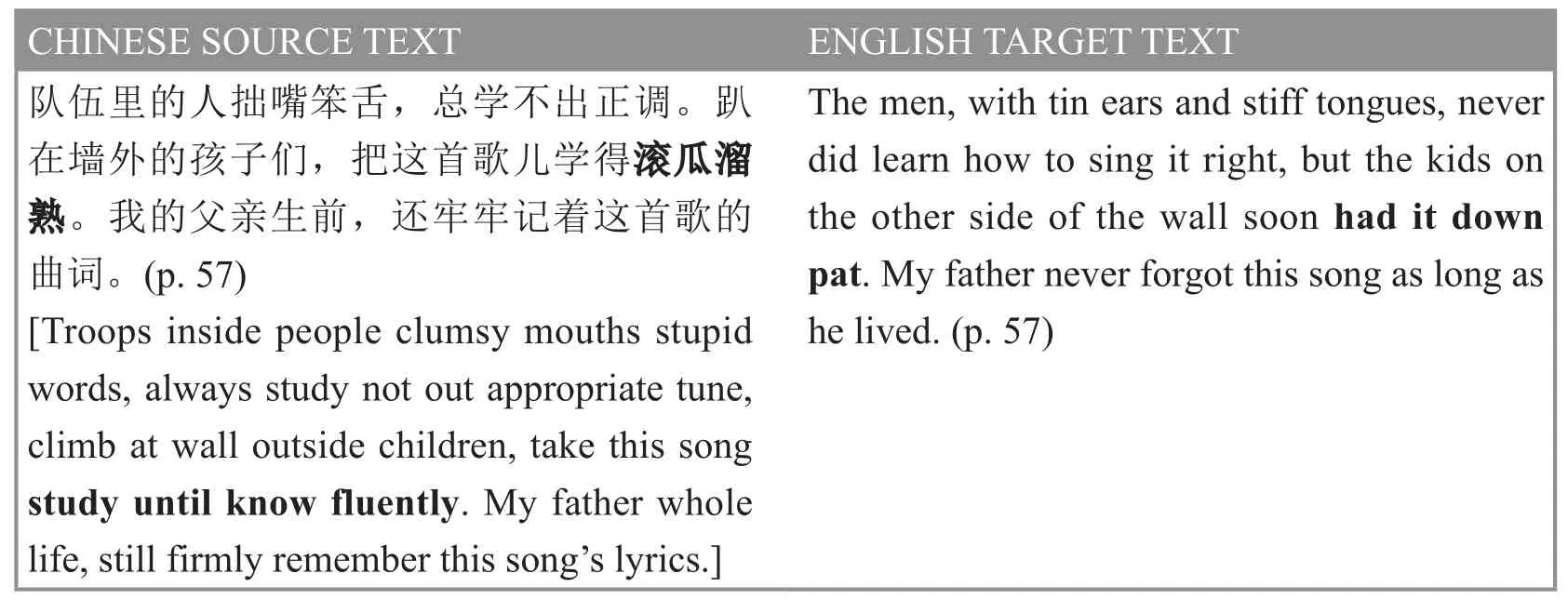
Fragment 7
The fragment above is an additional example of the translation of Chinese idioms found in the source text. Here Goldblatt translates the Chinese idiom [滾瓜溜熟] (fig. to know something fluently. lit. Ripe as melon that rolls from its vine) into English using an equivalent English idiom ‘had it down pat’, which again carries across a similar meaning to that of the Chinese source text. It is evident that Goldblatt has translated this Chinese idiom with the use of another English idiom, therefore conforming to both ST and TT linguistic and cultural norms.
It is through the evaluation and investigation into the above 7 fragments found in the first volume of the novel that one can determine the strategy which Goldblatt follows in terms of the translation of idioms, proverbs, and cultural phrases. It can be said that in terms of the translation of idioms found inRed Sorghum, Goldblatt makes use of target language idioms in the translation, should a suitable idiom exist. If there are no existing TL idioms, then the message must be carried across through employing sentences in the TL which are similar in meaning or through sentences which can adequately carry across the original idiom’s message. In several cases Goldblatt has translated Chinese idioms intoequivalent English idioms to retain the style of the original source text, hence following a domesticating approach that would allow for acceptability of the translation. This is the most effective way of translating culturally based idioms in that it allows the text to be understood and accepted by its target readers while still retaining the idiom usage of the original source text.
Measurements, Time, and Money
The second common translation occurrence that will be discussed is that of the translation of measurements, time, and money. In the English translation ofRed Sorghum, differences in measurements in the Chinese measurement system and Western measurement systems have been altered or additional information has been added to facilitate understanding. In this second category of operational norms, Goldblatt has adhered to English translation norms and made use of the addition of information in order for the English target readership to understand the novel, hence facilitating acceptability. Below are several examples which indicate the translation strategies employed by Goldblatt in these kinds of translations.

Fragment 8

Fragment 9
In the above two fragments the Chinese measurement ‘li’ [里] has been used in the source text as well as in the English target translation. If this were to be used on its own it would not be understood as it is a foreign concept to English language readers. The word ‘li’ [里] is used to describe a Chinese mile which is the equivalent of 500 meters in measurement.
In the two fragments above, Goldblatt decided to keep the original ‘li’ from the source text in the target translation, hence following a foreignising approach to the translation. He has however also added additional information in the fragment which appears first in the translated text in order for it to be understood by its target readers, hence also following a domesticating approach. With the addition of information such as ‘or about twenty by twenty-five miles’, Goldblatt allows the text to be understood by its readers while still giving them a sense of the original Chinese source text.
However in the second fragment, the English translation contains no further explanation as to what ‘li’ means, but assumes that the target readers are now aware of this new concept which has been explained a few pages earlier on in the novel. It can therefore be said that Goldblatt follows both a foreignising and domesticating approach, domesticating the concept when it first appears in the translation through the addition of extra information and later making use of the foreignising approach when the concept appears a second time around.

Fragment 10
In the above fragment the weight measurement has been altered in order to facilitate understanding. Hence, its main focus is on the acceptability of the translation. The original Chinese text states that Grandma weighs 60 kilograms which is translated as 130 pounds in the English target translation, employing a domesticating strategy to the translation. This fragment in particular shows that Goldblatt has taken his main target readership into account when translating, namely an American target readership. Many Englishspeaking target readers would be able to understand the translation had the translator used kilograms, however Goldblatt made the active decision to convert it to pounds both to ensure American target readers would accept the text, as well as to translate the sourcetext in a manner he was more familiar with.
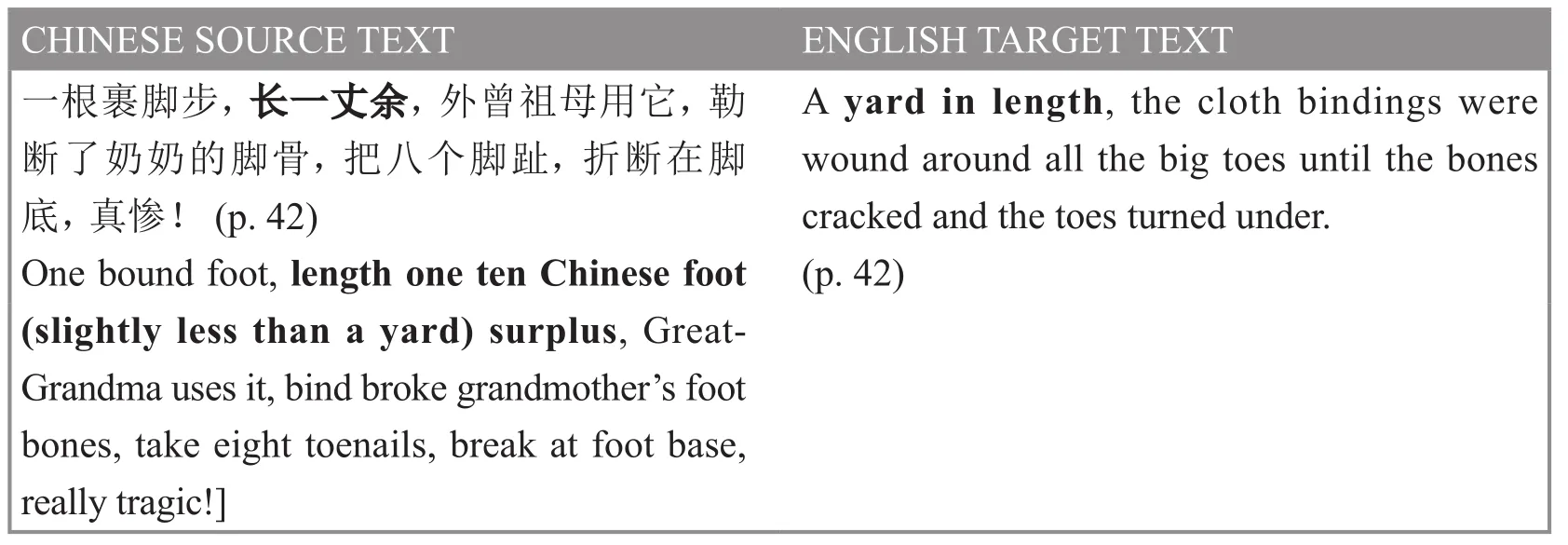
Fragment 11
This fragment is similar to the one above, in that measurements have also been altered for the target readership. At this particular time in Chinese history, it was common practice to bind feet, and hence a foot was measured at about 3 inches, therefore making ten feet the measurement of slightly less than a yard, which Goldblatt equates to one yard. Hence, the translation makes use of the American system of measurement which uses yards. In order to translate this information, Goldblatt would have had to have a good understanding of Chinese history and systems of measurement during the time at which the novel was written, using his own knowledge to equate this information into terms understandable by the target readership.

Fragment 12
In the following fragment also pertaining to measurements, Goldblatt translates the text again making use of a domesticating approach in which he converts the Chinese monetary unit of [塊大洋] ‘kuai silver yuan’ to ‘silver dollars’, which would be better understood by the target readership, once again using a unit of currency that he is more familiar with. He does not however change the amount indicated, retaining the number‘twenty’ in both currencies and in both source and target texts, indicating that the amount was not of vital importance to the storyline. It is evident that Goldblatt not only translates for his target readership but also translates in terms of his own knowledge, using terms of expression that he is most familiar with.
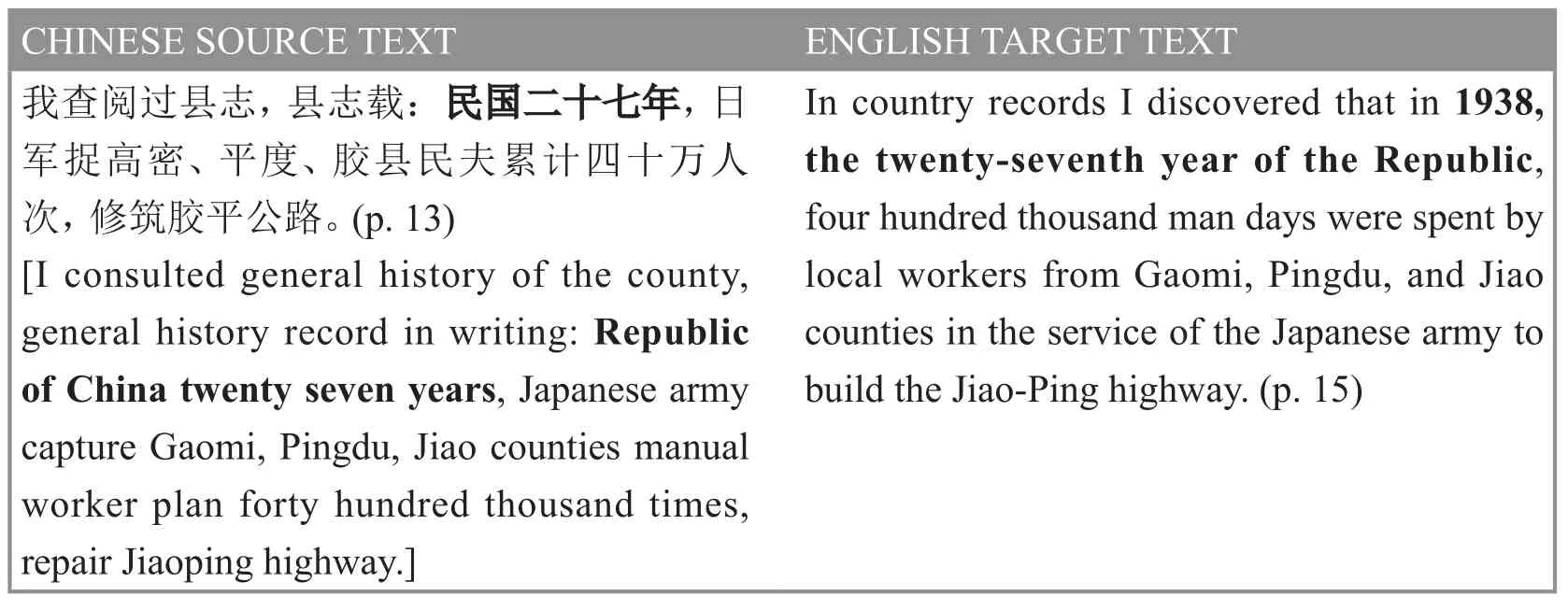
Fragment 13
The above fragment found in the translation makes use of an interesting way of writing the years. In the Chinese source text Mo Yan has used the years of the Republic, indicating how many years since China first became a Republic in 1912. In this particular fragment, [民國(guó)二十七年] (word for word translation: Republic twenty-seven year) is translated into English using a domesticating approach. The translation therefore includes 1938, while still retaining the sentence ‘twenty-seventh year of the Republic’ in the translation. This gives the English target readership the best of both worlds in that the reader is receiving both the original text while still being able to understand the exact year. In this way, Goldblatt is loyal to the original writer while bringing the source text to the target readership.

Fragment 14
The above fragment is an extension and further example of the fragment directly prior to this one in which a similar translation strategy has been employed in the translation of this part of the text. Goldblatt has again retained the source text information which states the ‘first year of the Republic’ while adding the actual year, 1912.
It can therefore be determined that in terms of the translation of dates, Goldblatt makes use of additional information in the target text in order to allow better understanding of foreign concepts when the dates are not universal between Chinese and English language speakers. In terms of the initial norms pertaining to dates, times, and measurements, Goldblatt also conforms to both ST and TT norms, using both foreignisation and domestication interchangeably.
Language Specific Descriptions
Language specific descriptions deal with the aspects that languages themselves present, complicating the translation process. These include phrases that if they were to be translated literally would not make sense at all. With two languages, such as Chinese and English, which have so many differences in the alphabetic/writing and pronunciation aspects, there is an abundance of language-specific descriptions that require the need for effective translation strategies.

Fragment 15
An additional example found in the translation ofRed Sorghumthat has been altered to better facilitate understanding is this part of the text which discusses the way in which the geese fly. In the original source text, Mo Yan uses Chinese characters to indicate the pattern in which the birds fly, namely the ‘one’ character and the ‘person’ character which form the same pattern as a straight line and an inverted V-shape. In the translation, Goldblatt has altered the text to make use of symbols that the English target readership would understand. This is vital in creating a text that will be received by the target readership, therefore taking acceptability into account.
Once again it is evident that Goldblatt often writes for the target reader, which is exactly as he claims to translate. In this example, Goldblatt adheres to the source text, with the alteration being made in the target text for better understanding amongst the target readership. In this particular translation, Goldblatt also omits information that does not have any relevance, such as the words ‘so on’.
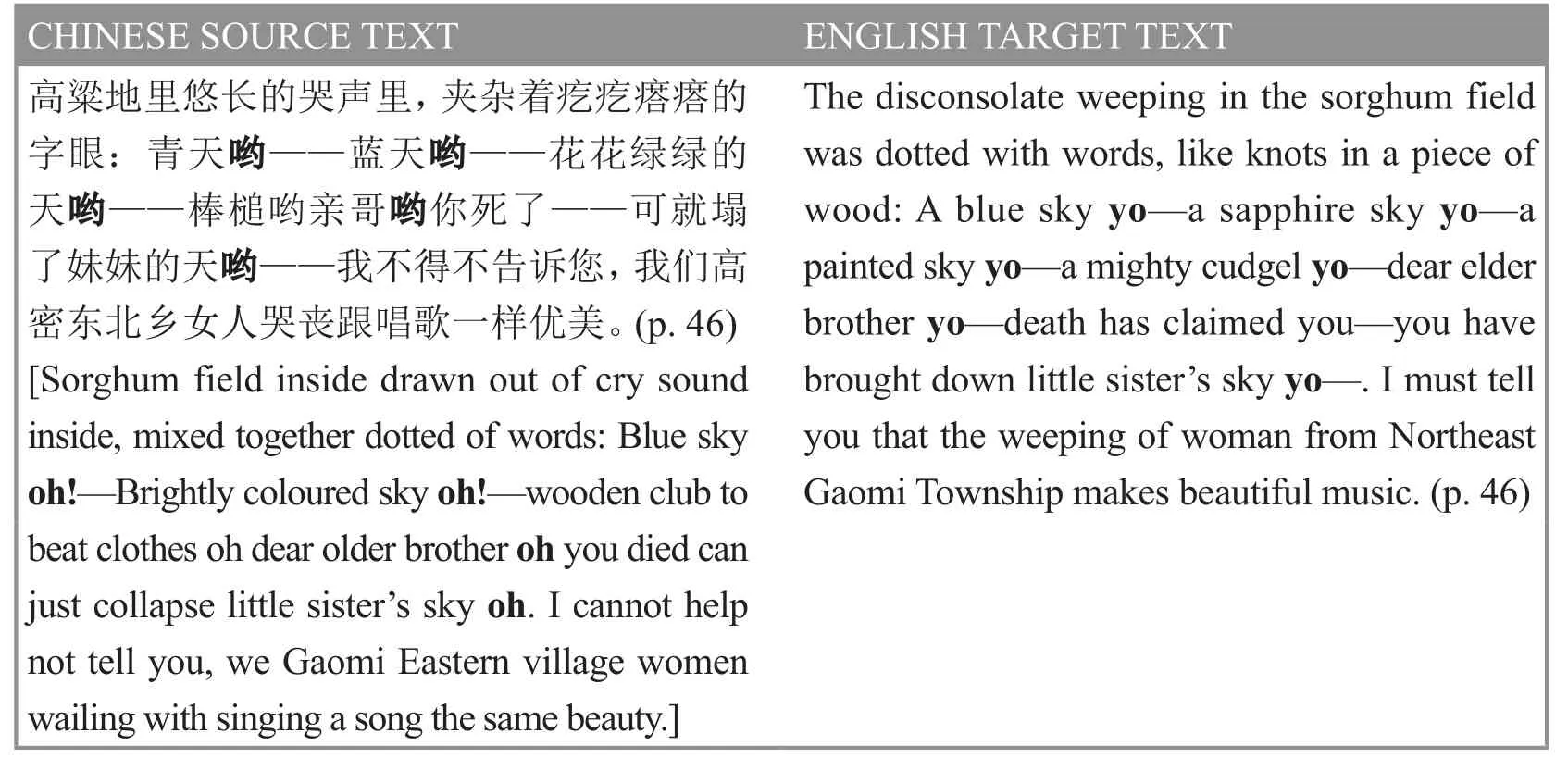
Fragment 16
In the above fragment, the target text translation has retained interjections found in the source text which are not commonly used in the English language. Goldblatt has therefore chosen source text norms over those of the target text, with the repetition of the words, ‘oh’ in the target text. These words do not serve any purpose in the text itself but rather serve the purpose of artistic language use. It is interesting that Goldblatt made the decision to keep these interjections as they do not in any way affect the understanding of the text but yet complicate the overall literary style of the English translation.
Onomatopoeia
The third translation category in terms of the operational norms is that of onomatopoeia, which appears very commonly in the source text. Onomatopoeia, “also known as echoism, refers to the formation of a word by imitating the natural sound associated with the object or action involved” (Yungen, 2001, p. 706). The translation of onomatopoeia and the task of vividly conveying the Chinese onomatopoeia presented in the novel into English is not an easy task but it is an important part of translation. Goldblatt employs three different strategies in the translation of these, namely paraphrase, interpret, and rewrite.

Fragment 17
In the above fragment, Goldblatt has recreated the artistic effect in the target translation, hence following the interpreting approach to the translation of onomatopoeia. The use of the words ‘Minliwala, yalalimin’, which are not in existence in the English language, reproduces the original artistic effect which is very similar to the Chinese words [嗚哩哇啦啞啦哩嗚] ‘wuliwalayalaliwu’, which also have no actual meaning but only represent sounds.
Another interesting translation decision made by Goldblatt in this particular fragment is the translation of the words [日本鬼子] (word for word translation: Japanese Ghosts) which is a Chinese cultural expression used to refer to the Japanese soldiers during the Sino-Japanese War. This was considered a very degrading term for the soldiers. However, Goldblatt has decided to translate this in a peaceful manner, making use of ‘he’ instead of translating the name for the Japanese soldier. He has perhaps avoided this translation, knowing that the Western target readers would not understand the hatred in the words of the original Chinese writer.The second example of the translation of onomatopoeia in the translation ofRed Sorghumis the above example of Grandma drinking her wine. Goldblatt has here made use of a paraphrase strategy. Instead of explaining exactly how Grandma drinks her wine, he simply adds the word ‘noisily’, leaving the target readers to imagine the noises she makes. This could be for two reasons, the first of which being that there is no exact English translation in existence for the Chinese onomatopoeia used in the text. Secondly, it could be due to the fact that Goldblatt felt that the nature of the Chinese language stipulated that particular usage, and therefore found the best approach would be to find an equivalent way of writing the same sentence in English, which the target readers would understand.

Fragment 18

Fragment 19
The third example of onomatopoeia found in the translation is one in which Goldblatt uses the interpreting approach to translation. He therefore translates making use of theword ‘cooed’, which is the English equivalent for the bird sounds in the source text.

Fragment 20
This fragment contains further examples of the translation of onomatopoeia in the translation ofRed Sorghum. Once again, Goldblatt has made use of an interpreting strategy. This could be as a result of there being no actual translation that exists for the Chinese source text onomatopoeia, leading to the translation of ‘shh-shh’ in the English target text.

Fragment 21
The above fragment is another example of translation of onomatopoeia inRed Sorghum, which has been directly interpreted into English, even retaining the noun ‘gun’ in the translation.
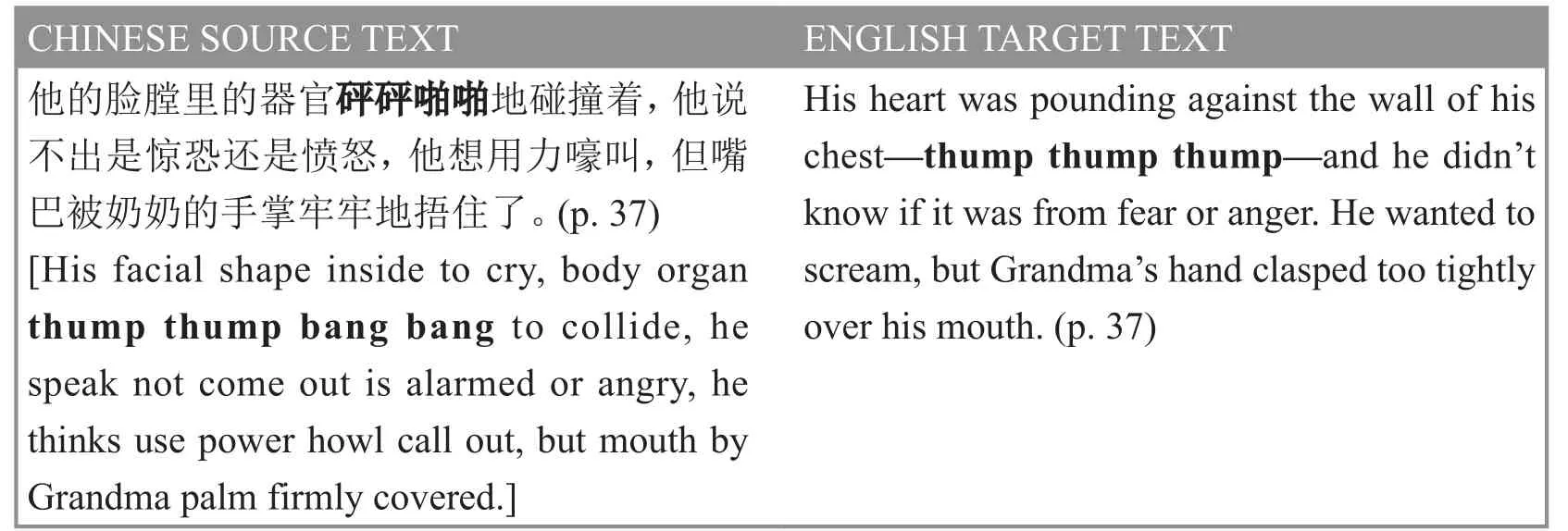
Fragment 22
The above fragment, which contains onomatopoeia in the source text, discusses the sound made by the heart. The Chinese heart sound has been translated into the English equivalent sound, therefore following an interpreting strategy.

Fragment 23
The translation of this fragment containing onomatopoeia makes use of a rewriting strategy, as there is no exact equivalent of the onomatopoeia that is found in the source text. In fact there is no actual English translation for the words [克朗克朗], therefore Goldblatt is forced to follow a rewriting strategy.
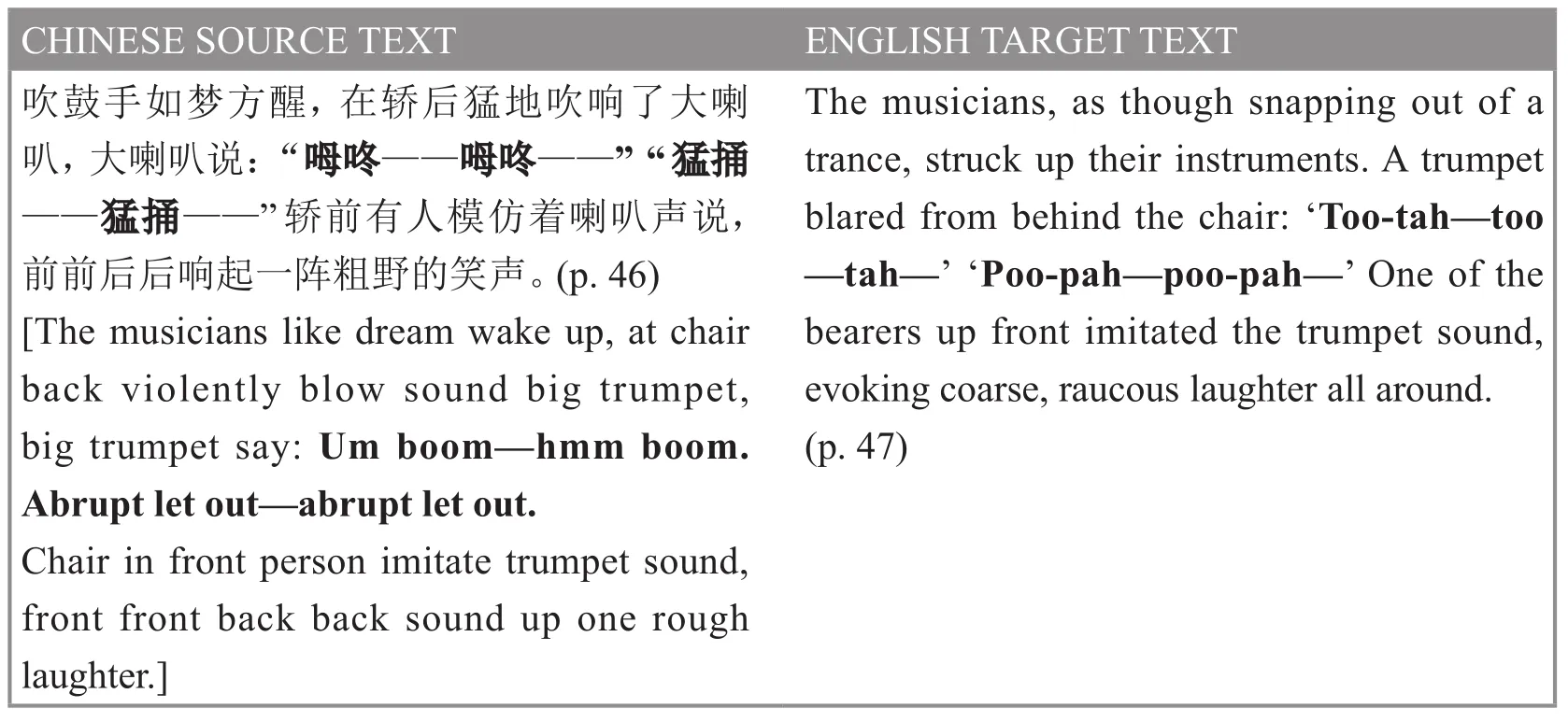
Fragment 24
In the above fragment Goldblatt also makes use of a rewriting strategy, translating the Chinese original source text into English as ‘Too-tah—too-tah—’ ‘Poo-pah—poo-pah—’, hence allowing acceptability.
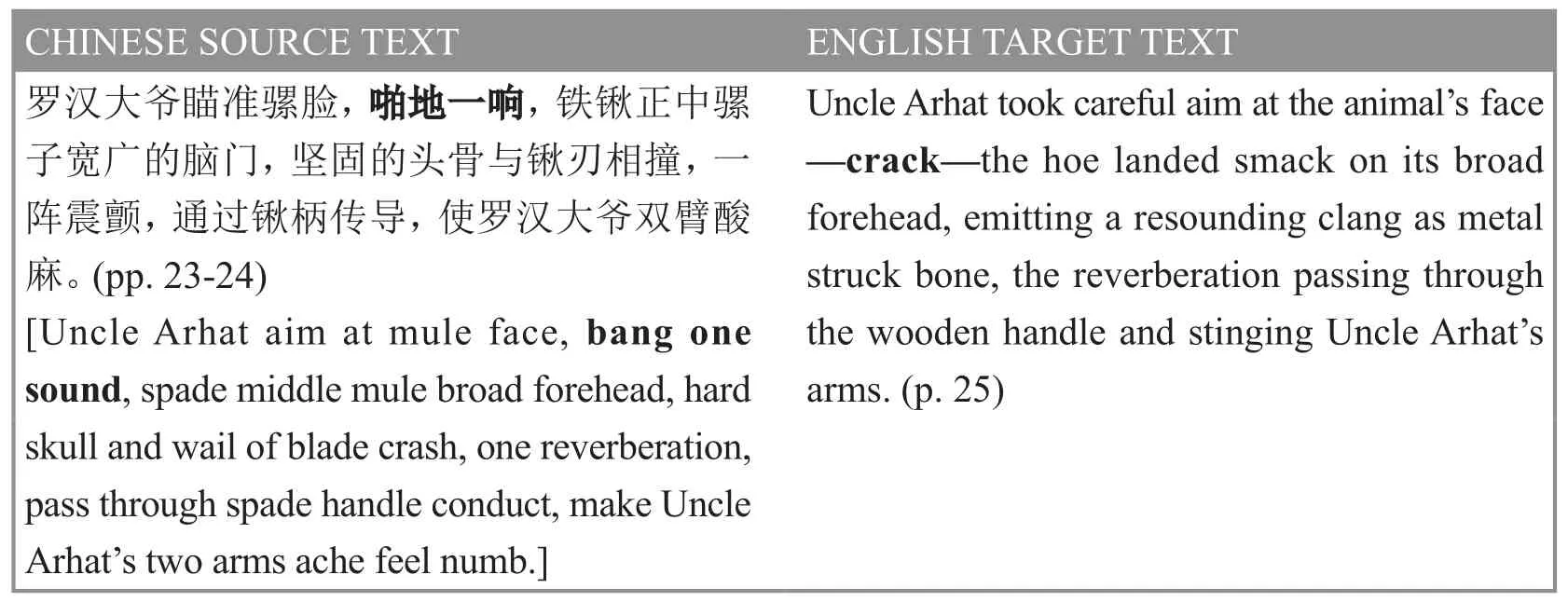
Fragment 25
Lastly, the final example of onomatopoeia in the novel shows how Goldblatt has employed a rewriting strategy in the translation of [啪地一響] (word for word translation: bang one sound) through the use of the word ‘crack’ in the English translation.
Omissions
There are several examples of omissions in the translation ofRed Sorghum. These often occur due to the cultural or historical gaps between China and the West, but could also be a result of the information being redundant should it be translated in the target text.

Fragment 26
In the English target translation, Chinese cultural and historical knowledge has been omitted. In the above fragment Goldblatt has omitted information pertaining to Marxism. The omission of this sentence could be a result of English readers finding it incomprehensible and perhaps insignificant. Marxism is very much rooted in Chinese history, and his literature was often translated into Chinese, which resulted in many Chinese students studying his ideology. It can therefore be said that it is normative, according to Goldblatt, to omit information that does not affect the target text reader’s understanding of the text should the information that is being omitted contain information that is not important to the target readership.
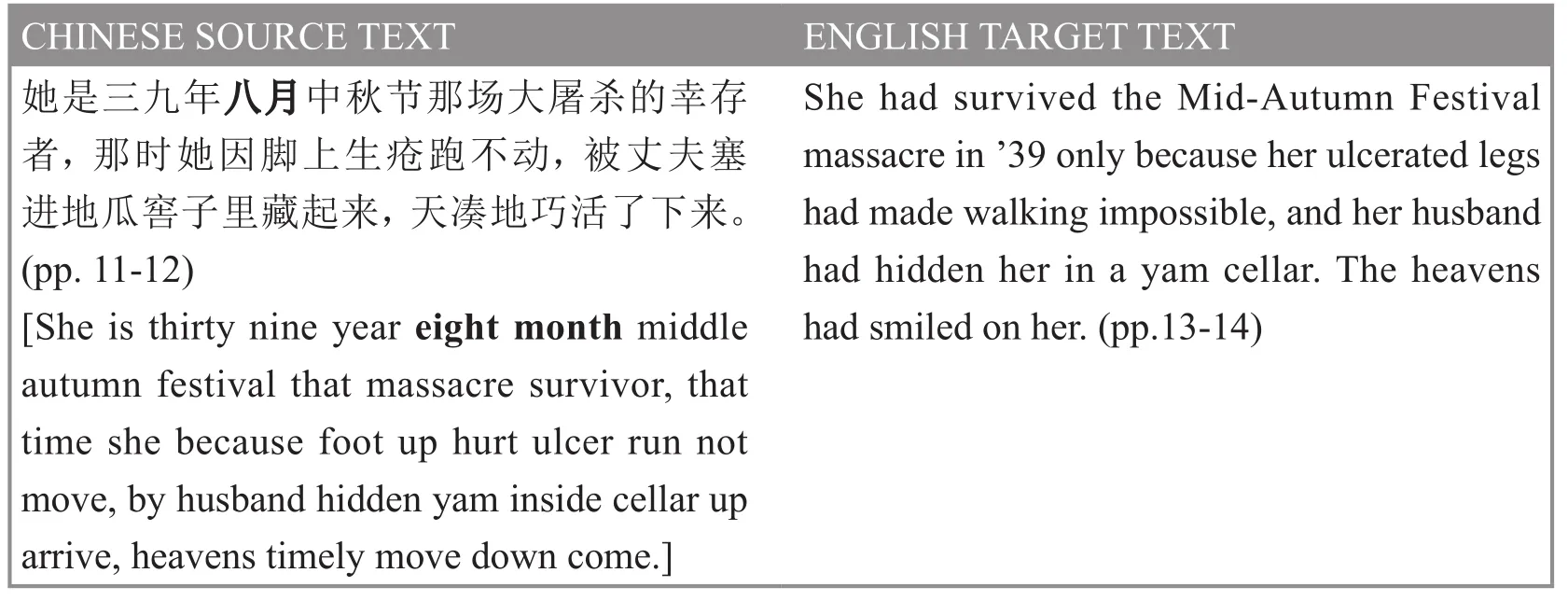
Fragment 27
An additional example of omissions in the target text is the above fragment which omits dates from the source language in the English translation. Due to the differences in Chinese Lunar calendars and Western Gregorian calendars, the date of the Mid-Autumn festival would take place in different months of the year. Therefore, information in the source text pertaining to the actual month in which the Mid-Autumn Festival took place has been omitted in the target translation. If this date had been translated directly, it could be confusing, hence the omission of the month in the target text.
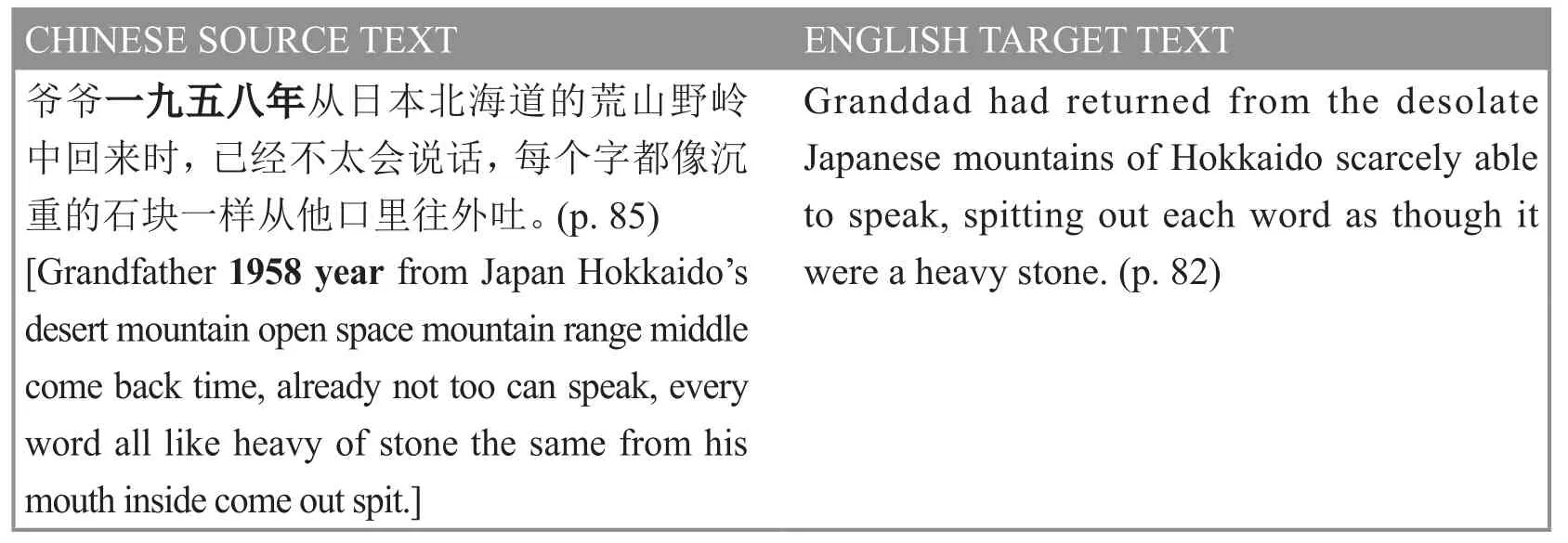
Fragment 28
This fragment also indicates the omission of information in the English translation ofRed Sorghum. The year 1958 is completely omitted from the target translation. This could be a result of incorrect information presented in the Chinese source text, which has now been corrected in the translation, as Howard Goldblatt states in his translator’s note. This information could also be omitted as a result of it not serving a purpose in the English translation.
Additions
Additions to the source text are often used in the translation in order to better facilitate understanding for the target readership or to allow for cohesion. Below are a few of the examples where Goldblatt has used extra information to facilitate understanding as well as allow for cohesion in the target text.
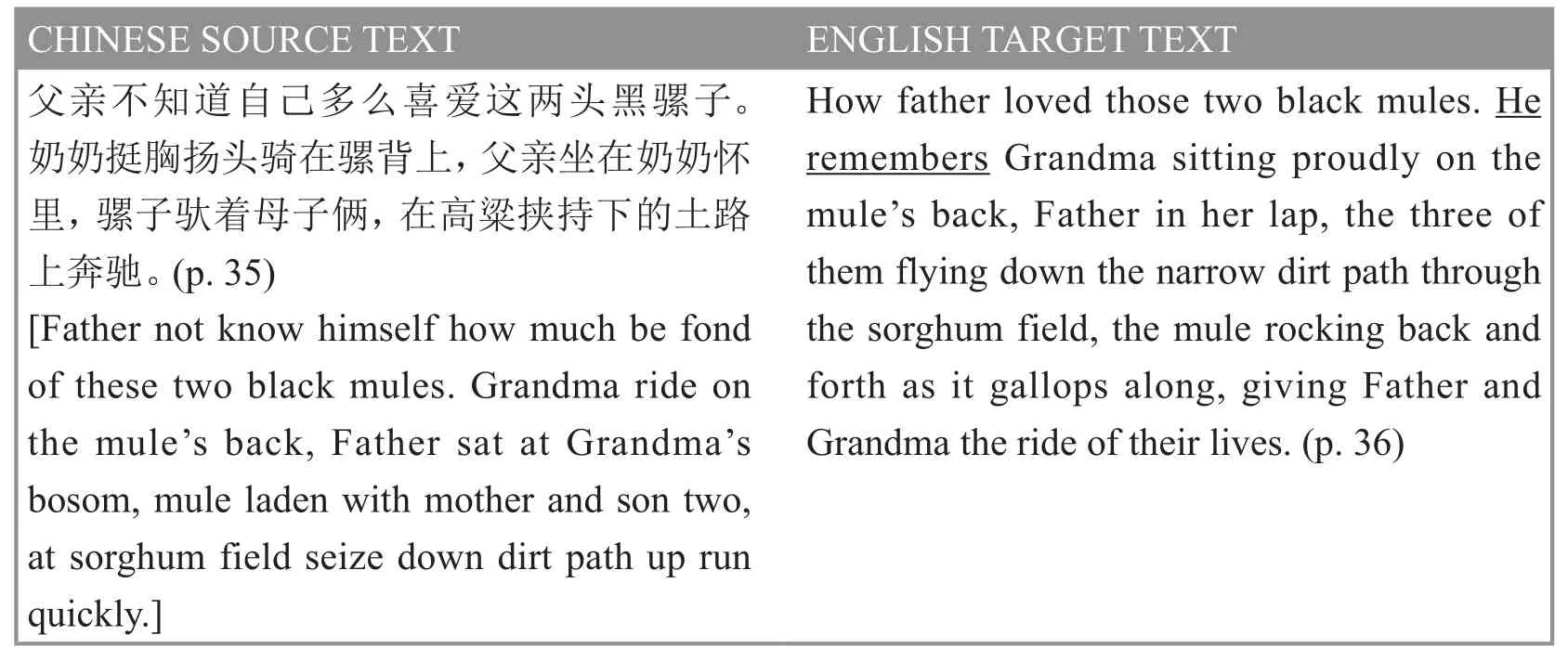
Fragment 29
In the above fragment Goldblatt makes additions in the target text. In the fragment he adds ‘He remembers’ in the target text translation which creates cohesion, allowing for easier acceptability of the target readership in terms of the translation. Goldblatt has hence attempted to make the translation idiomatic and fluent in the target language through the addition of short phrases that create cohesion.
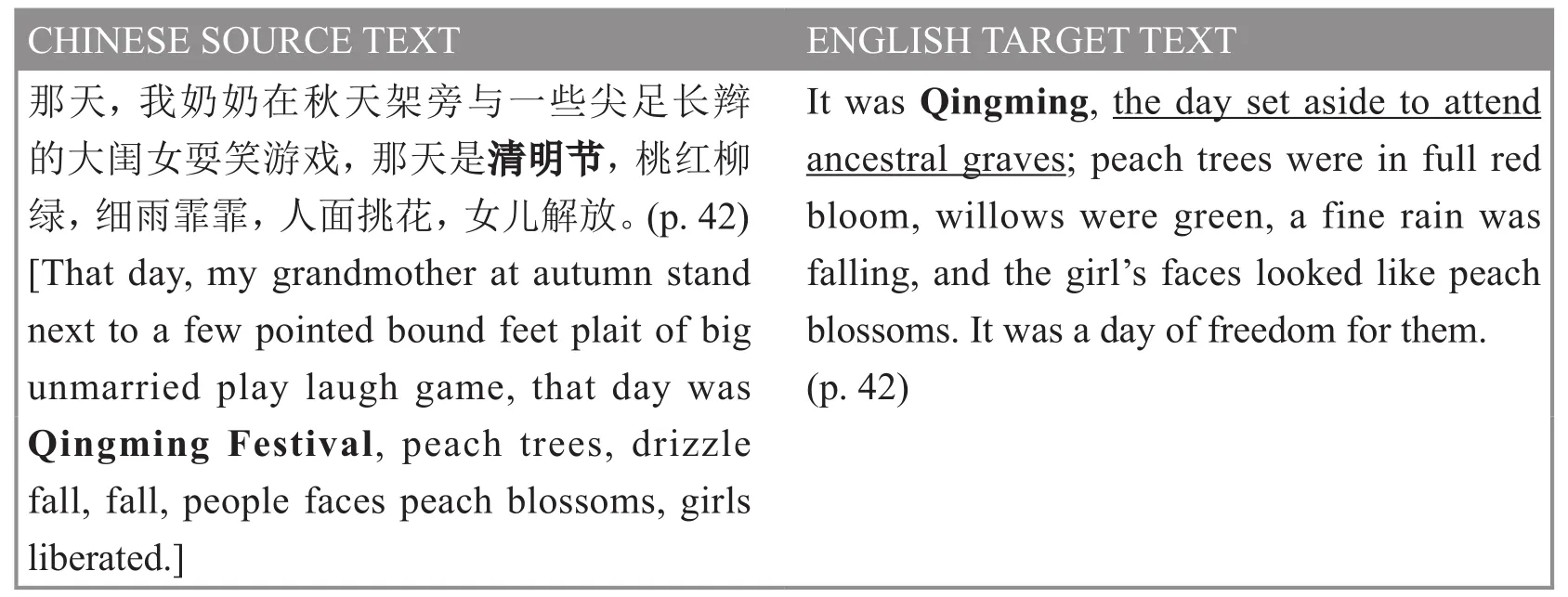
Fragment 30
In the above fragment, Goldblatt adds information to the target text in order to facilitate understanding amongst the target readership. The Chinese festival ‘Qingming’ will not be understood by target readers should it be directly translated, thus the addition of information in the target text which explains what the Qingming festival is about. It is therefore obligatory for the translator to add information in this particular instance, since the word ‘Qingming’ has little meaning to English target readers who are not familiar with Chinese festivals or culture.

Fragment 31
The above fragment is another example of addition in the target text translation. Goldblatt adds additional information about the stars in this fragment, namely ‘Rigel, Betelgeuse, and Bellatrix’, which are not found in the source text. Rigel, Betelgeuse, and Bellatrix are three stars known for their brightness. Goldblatt could have made this addition in order to add interesting facts or ideas to the target translation.
Name Translations
Due to the vast differences between the Chinese and English languages, the translation of names and proper nouns is interesting and can vary. When translating names, one can transliterate the name, translate the name or combine both transliteration and translation of the name. Below are several examples of the approaches that Goldblatt takes to the translation of names.
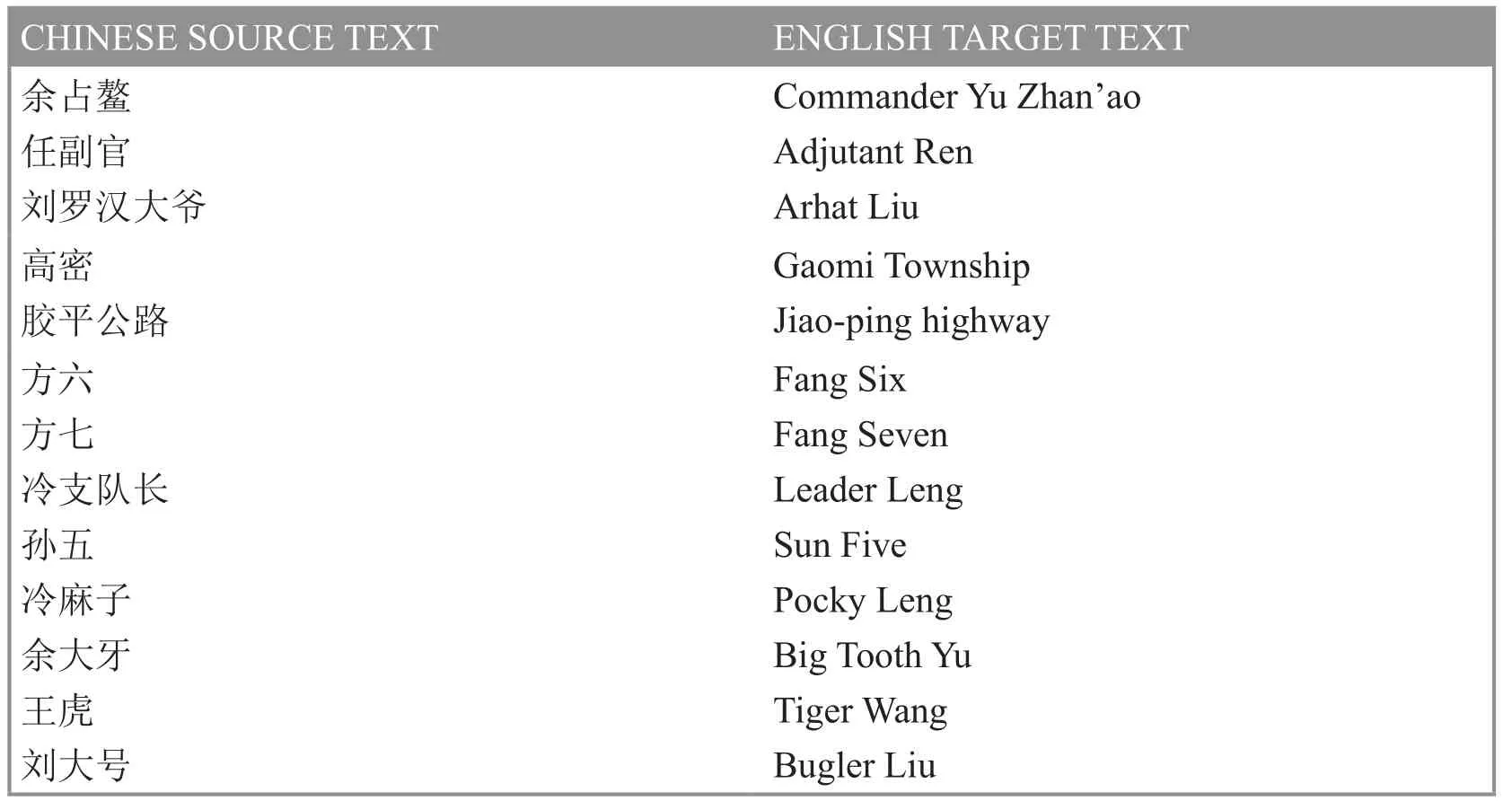
Fragment 32
Of the many examples found in the English translation, the majority of the names are transliterated from the original Chinese sounds, thus applying a foreignising approach to the translation of names and taking the source text into account.
Several of the names, place names, and proper names have however also been translated. These are generally names which have a meaning that bears some kind of significance to the storyline, such as the name ‘Mute’ found in the novel. This strategy is common in English translations of Chinese documents which require the meaning of the name in order for the text to be understood. The above fragment contains examples of names that have been transliterated from the original Chinese names with an additional translation. There are 13 names found in the first volume of the translation ofRed Sorghumwhich have been translated in this way.
The second strategy employed by Howard Goldblatt in the translation of names, proper names, and place names is the strategy of plain translation.

Fragment 33
The above three names found in the first volume of the novel,Red Sorghum, have been translated into English. This is mostly due to the fact that they have either officialtranslations or have some sort of significance in meaning in the original Chinese source text which is relevant to the target text. The name ‘Mute’, for example, requires translation in order to facilitate understanding in the target text as the name plays a specific role in the story describing an essential characteristic of a character which is vital to the plot.
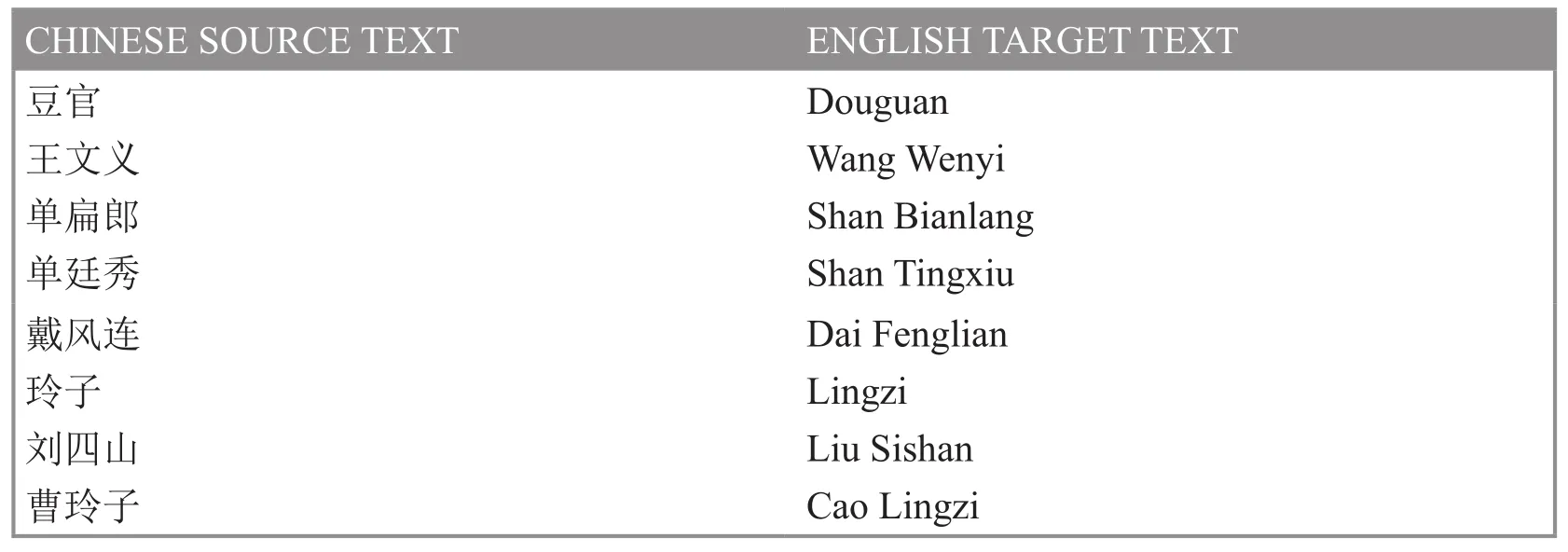
Fragment 34
The second fragment consists of names that have been transliterated from the original Chinese names and kept in this way in the English translation. Goldblatt has therefore attempted to foreignise the text, allowing the target reader a sense of the original characters’ names. This strategy is the simplest way in which names can be translated as there is no need for the creation of names that would usually be used in the target language and culture. There are 8 names that follow this particular strategy.
From the above examples of the translation of names, proper names, and place names in the first volume ofRed Sorghumit can be said that the most common approaches to translating names employed by Howard Goldblatt in Chinese-English translations is transliteration and translation. He therefore follows both a domesticating and foreignising approach, which can be considered the norm in his translations of this particular novel. Once again it is shown that Goldblatt adheres to both the ST language and culture norms as well as the TT language and culture norms.
Repetitions
An additional category which arises as a result of the differences between languages, and shows the differences in linguistic norms between the two languages, is repetition. In Chinese it is common to repeat words for emphasis, however in English the tone of voice expresses this emphasis. Hence, in the translation ofRed Sorghum, repetitions in the Chinese source text have not been repeated in the English translation because they would be seen as redundant.

Fragment 35

Fragment 36
The following fragment shows how repetitions have been removed when translated into English.

Fragment 37
The above fragment not only shows the translation decisions made by Goldblatt in terms of the vulgar language used, but in addition shows the repetitions found in the source text. In the following fragment, the swear words which are repeated in the source text are only written once in the target text. Goldblatt therefore follows norms that are specific to the target readership and does not follow those of the original source text language and culture, hence removing redundancies. Goldblatt however can only employ this strategy when it does not affect the meaning of the source text. Toury calls this strategy “simplification”, describing this norm as “one of the most persistent, unbending norms in translation in all languages studied so far” (Toury, 1991, p. 188). In this, and many other fragments of the novel, Goldblatt uses the simplification norm.
The second sub-category of operational norms is that of textual-linguistic norms (see Toury, 1980, Chapter 2 Page 12). The following few fragments consist of the examples which show the choices made by Goldblatt in terms of these textual-linguistic norms.
Lexical Choices
Lexical or word choices occur often during the translation process, leaving the translator to decide on the most suitable choice. Several of the fragments below indicate Goldblatt’s approach, which is often to use a word that is familiar to his target readership.

Fragment 38
In this fragment, the expression ‘Atten-hut’ has been used in the English translation. The use of this expression is interesting in that ‘Atten-hut’ is a word that is specific to the American army. Goldblatt has therefore translated with the target readership in mind, avoiding using the universal word ‘Attention!’ but rather making use of a common American English expression.
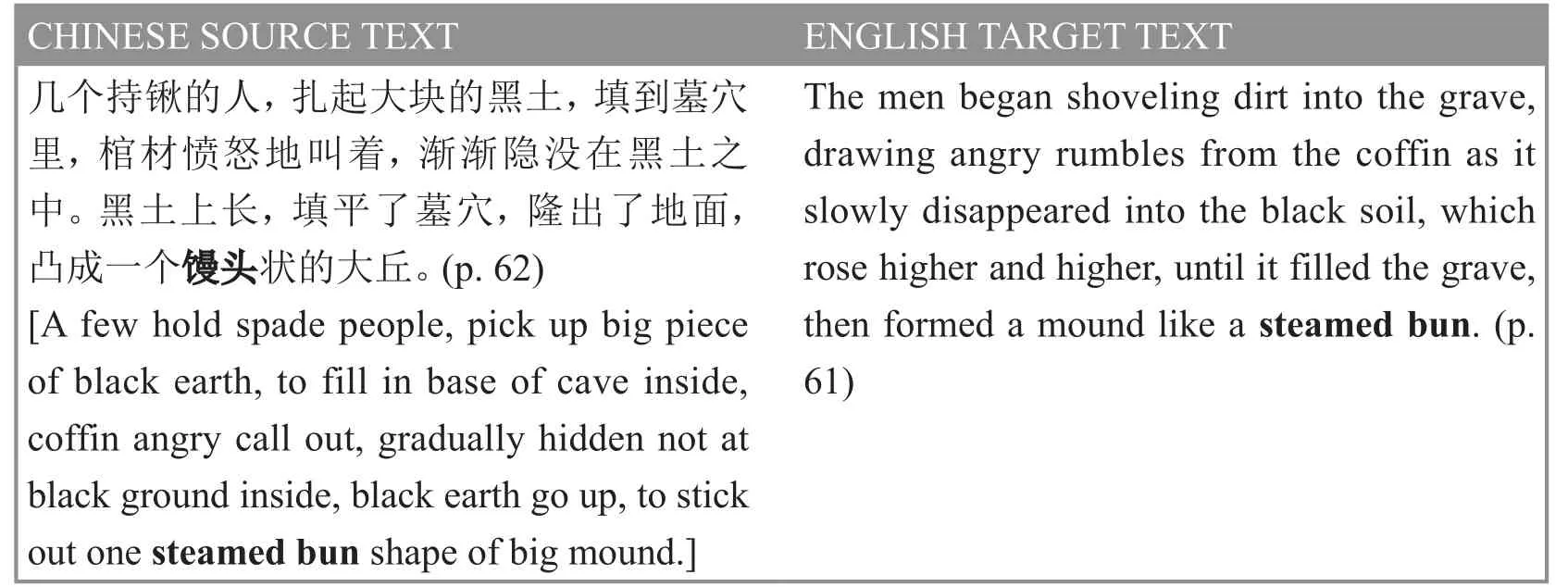
Fragment 39
In this fragment, the Chinese word [饅頭] (a Chinese bun/roll) has been translated into English as a steamed bun. Although this is the English equivalent translation, it is interesting that Goldblatt made the decision to use this word and not equate the term to a more common English or Western food item to facilitate better understanding amongstthe target readership. He has used a foreignising approach here, therefore following the adequacy component of initial norms while also choosing not to replace it with a more common American food item.

Fragment 40
A second example that makes use of Chinese food items in the translated text is the following fragment which contains ‘fistcakes’. Many English target readers would find this a foreign concept, and only based on the context would they be able to understand that it is a food item. However, this second example, and the example prior to this one, show the approach taken by Goldblatt in terms of translating foreign foods or names of items that are peculiar to a certain area or country. He employs a foreignising approach to the translation of such items.

Fragment 41
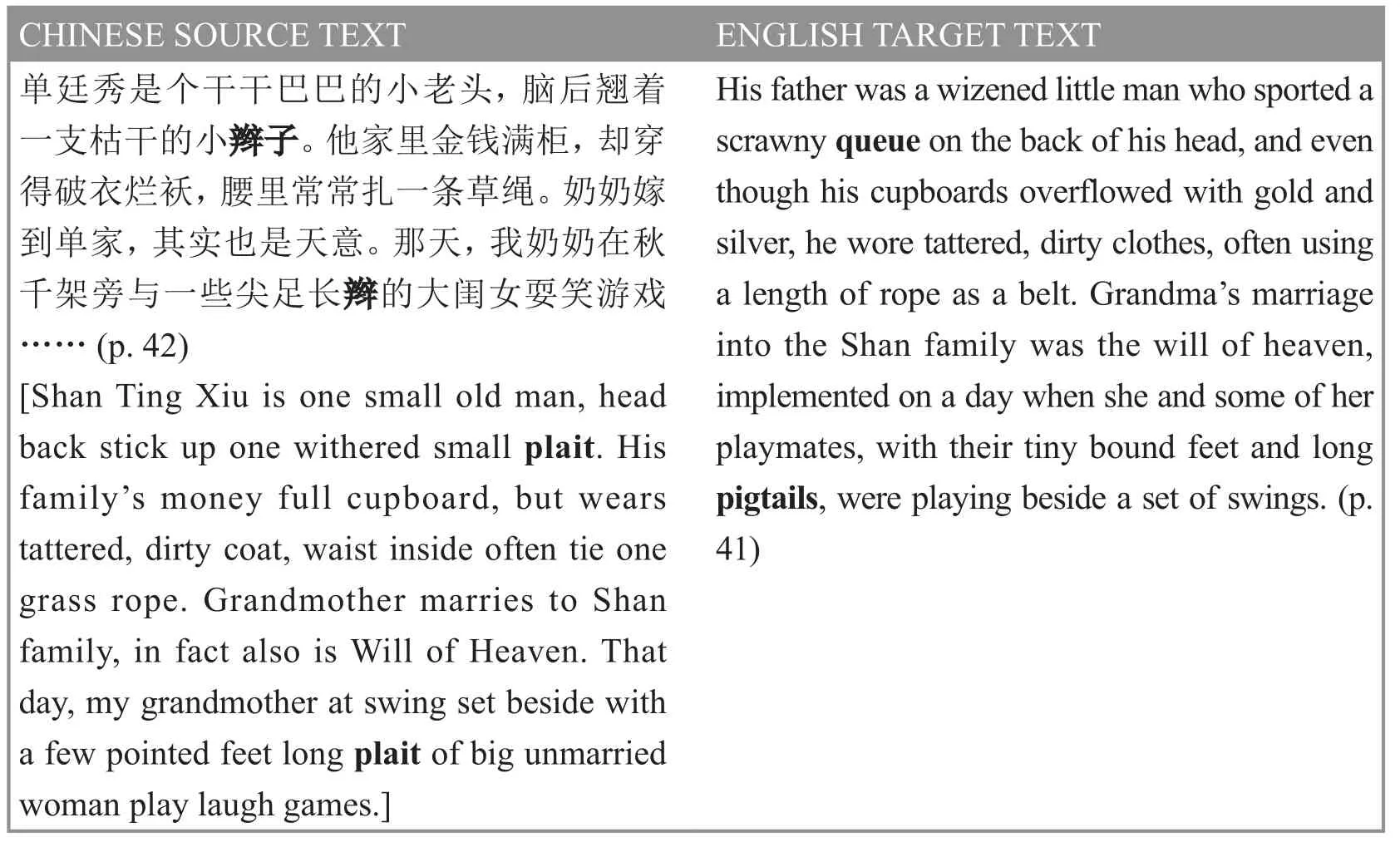
Fragment 42
Another interesting translation decision made by Goldblatt in terms of word choices are the words contained in the above two fragments. The above two fragments make use of the word ‘queue’ which is commonly used to refer to a plait or pigtail at the back of a Chinese man’s head. What is interesting is that Goldblatt has decided to use this particular word instead of the more common word ‘plait’, which would most probably be more widely understood. Furthermore, he also uses pigtail and plait interchangeably for the translation of the same Chinese word. Here he tries to maintain a text that is culturally specific to the Chinese culture and traditions with the use of English words.
It is therefore evident that Howard Goldblatt makes use of several different translation strategies. In some instances he uses artistic effect to recreate the source text in order to enhance readability for his English language readers and in other instances he makes use of foreignising approaches and retains the source text elements that are foreign to his target readership.

Fragment 43
There are several examples of translations found in the novel that have been slightly altered. The above fragment could be the result of the information being slightly altered or could possibly be the difference in opinion of the meaning of the original Chinese source text. In the above fragment instead of saying ‘just passed his fourteenth birthday’ [十四歲多一點(diǎn)] (word for word translation: fourteen more a little) Goldblatt decided to translate the source text into English as ‘who had passed his fifteenth birthday’. Due to the fact that this translation does not seem logical, it could most likely be considered an alteration in the novel as stated by Goldblatt in his translator’s note.

Fragment 44
Secondly, another fragment containing altered information is found in the translation ofRed Sorghum. In the above fragment, ‘mother’ in the source text has been replaced with ‘father’ in the target text. This could be a result of incorrect information in the source text which has been altered for the translation of the target text.
Concluding Remarks
Goldblatt states that he writes for the readers and not for the author. Several of the fragments prove this statement to be fairly accurate. This article has investigated different aspects of Goldblatt’s English translation ofRed Sorghum. The first aspect was that of the translation of idioms, cultural expressions, and proverbs. From the investigation into the fragments containing idioms, cultural expressions, and proverbs, it can be said that Goldblatt often makes use of a domesticating strategy in these instances. This is evident in the use of several English target language expressions, idioms, and proverbs in the translated text. For example, ‘grease the skids’ (fragment 4) and ‘Soldiers are easy to recruit, but generals are worth their weight in gold’ (fragment 3), which are similar in meaning to the original Chinese idioms or expressions, therefore carrying across a similar message.
The second aspect is that of money, time, and measurement. Goldblatt follows a similar approach to the first aspect, in that he often equates Chinese units of currency and Chinese measurements to common American measurements, namely dollars and yards. It is only, however, in a few examples of the translation of Chinese dates and words that heretains the original source text words. For example, the word ‘li’ found in fragments 8 and 9, which he retains with the addition of information in the first instance it appears in the novel, in order to facilitate acceptability amongst the target text readers. In terms of the dates, Goldblatt has used both a foreignising and domesticating approach simultaneously. He does this by presenting the original date in a similar way to the Chinese source text while still allowing acceptability through the addition of information in the target text. For example, fragment 13 which contains ‘1938, the twenty-seventh year of the Republic’.
The third aspect that was researched is the language specific descriptions. When it comes to the problem of translating language specific descriptions, Goldblatt often employs a domesticating approach. This is evident in the several examples which he has altered in order for the target readership to better understand the concept that is explained in the source text.
The fourth aspect is that of onomatopoeia. There are several examples of onomatopoeia found in the target translation that have been interpreted, and a few that have been rewritten. It can therefore be said that the most common translation strategy employed by Goldblatt during the translation of onomatopoeia is the interpreting strategy, which is closely followed by rewriting. This also indicates the strategy which Goldblatt employs in terms of operational norms. By making use of the rewriting and interpreting strategies, Goldblatt sticks closely to the source text linguistic norms while still creating a text that will be accepted by the target audience, whereas if he often made use of paraphrase it would mean that his focus was only on the target language and culture and their norms.
The fifth aspect is that of omissions. In the target text, Goldblatt employs a domesticating approach in that he often omits information that is not vital to the target text or information that would be misunderstood should it be directly translated. This is evident in fragment 26, where information with regards to Karl Marx’s ideology is omitted in the target text.
Another aspect that was researched in this chapter is that of additions. In terms of the additions found in the fragments above, one can conclude that Goldblatt makes use of additions in the target text in order to give more information about the Chinese source text to facilitate acceptability of the translated text; once again he is employing a domesticating approach.
In terms of the translation of names, Goldblatt employs three different strategies, namely plain translation, transliteration, or transliteration and translation. The most common of these strategies found in the text is that of transliteration and translation, which is evident in that the majority of the names found in the text are transliterated and translated. Therefore, Goldblatt is employing both a domesticating and foreignising strategy.
Once again Goldblatt makes use of a domesticating approach in terms of the repetitions found in the source text. Repetitions are very common in the Chinese language, due to the fact that it conveys an emphasis that the tone of voice usuallyconveys in English. Goldblatt has therefore decided to remove several of the repetitions that appear in the source text when translating for the target readership.
The final aspect that was researched is that of lexical choices. Goldblatt has translated many of the source text words for the English target readership, such as the example presented in fragment 38, where has used the word ‘a(chǎn)tten-hut’, which is a term commonly used in the American army. He has however also used another approach in terms of the translation of common Chinese food items, refraining from changing these items to food items that Americans or Westerners are more familiar with. For example, keeping the terms ‘fistcake’ and ‘steamed bun’ in fragments 37 and 38, which perhaps allow the target readership a sense of the original author’s writing.
In summary, one can therefore determine from the fragments found in the text that the initial norms are in line with the operational norms. The fact that Goldblatt translates for the target readership shows he is applying a domesticating approach to the translation. However, Goldblatt does still stick closely to the original source text information, retaining several of the Chinese idioms, phrases, names, and words, while at the same time allowing for acceptability by the target readership through either alterations, paraphrase, or additional information. In the translation ofRed Sorghum, Goldblatt has used the source text as the main frame of reference, aiming to translate the words of Mo Yan himself as much as possible. In several instances he does however bring the writer towards the readers, domesticating translation in order to write for the target readership.
Given the above fragments pertaining to operational norms found in the English translation ofRed Sorghumby Goldblatt, one can see from the of examples, which both retain source text elements and alter these elements through the addition of information in target text translations, that the initial norm is neither solely source text orientated nor solely target text orientated, but rather a combination of both, with most of the focus on the target readership, and acceptability and domesticating the translation.
In conclusion, the investigation into Mo Yan’s novelRed Sorghum, has resulted in a better understanding of the translation strategies employed by Howard Goldblatt and his translation process, and one is also able to better evaluate the translation product which he has produced, therefore also providing a descriptive study of the novel. Through investigations into the translation strategies one is also able to determine the translational norms.
Notes
1 Red Sorghum Clan in Chinese 紅高粱家族.
2 [娘] ‘niang’ meaning mother and [爹] ‘die’ meaning father
Avery, M. (2014).Mo and me: I challenge Mo Yan to a novel marathon. Ontario: Lulu.com.
Baker, M., & Saldanha, G. (Eds.). (2008).The Routledge encyclopedia of translation studies(2nd ed.). Manchester: Routledge.
Chesterman, A. (1993). Translation as theory.K??nt?j?,1(3). Retrieved from http://www2. translegis.com.pl/ll_archiwum/LL_2_13.pdf
Chesterman, A. (1997).Memes of translation: The spread of ideas in literary translation. Amsterdam/ Philadelphia: John Benjamins Publishing Company.
Cohorst, K. (2012).Professor from Notre Dame translates Nobel winner’s novels. Retrieved from https://al.nd.edu/news/34315-professor-from-notre-dame-translates-nobel-winners-novels/
Davis-Undiano, R. C. (2012).A westerner’s reflection on Mo Yan. Retrieved from http://www. worldliteraturetoday.org/westerners-reflection-mo-yan
Goldblatt, H. (2009). Mo Yan’s novels are wearing me out: Nominating statement for the 2009 Newman Prize.World Literature Today,83(4), 28-29.
He, X.-B. (2005). Translation norms and the translator’s agency.Translation Today,2(1), 50-62.
Hermans, T. (1996). Norms and the determination of translation. A theoretical framework. In R. álvarez & C. Vidal (Eds.),Translation power subversion(pp. 25-51). Clevedon: Multilingual Matters.
Hermans, T. (2009).Translation in systems. Manchester: St Jerome.
Hermans, T. (2013). Norms of translation. In C. A. Chapelle (Ed.),The encyclopedia of applied linguistics(pp. 4262-4268). Blackwell Publishing Ltd.
Hewitt, D. (2012).Hallucinatory realism of Mo Yan, the first official Chinese winner of the Nobel Prize for Literature. Retrieved from http://www.thedailybeast.com/articles/2012/10/11/ hallucinatory-realism-of-mo-yan-the-first-official-chinese-winner-of-the-nobel-prize-forliterature.html
Inge, M. T. (2000). Mo Yan: Through western eyes.Board of Regents of the University of Oklahoma,74(3), 501-506.
Kirkus. (2010). Kirkus review:Red Sorghum. Retrieved from https://www.kirkusreviews.com/ book-reviews/mo-yan/red-sorghum/
Landers, C. E. (2001).Literary translation. Clevedon: Multilingual Matters.
Levitt, A. (2013, April 11). Howard Goldblatt’s life in translation. Retrieved from http://www. chicagoreader.com/chicago/howard-goldblatts-life-in-translation/Content?oid=9260454
Lin, S., & Yan, M. (2006). My American books.Beyond Words: Asian Writers on Their Work,18(1), 31-35.
Lingenfelter, A. (2007). Howard Goldblatt on how the navy saved his life and why literary translation matters.Full Tilt: A Journal of East-Asian Poetry Translation and the Arts,2. Retrieved from http://fulltilt.ncu.edu.tw/
Link, P. (2012).ChinaFile. Retrieved from http://www.chinafile.com/links/Perry-Link-Does-Writer-Deserve-Prize
Logan, P. M. (Ed.). (2011).The encyclopedia of the novel. West Sussex: Wiley Blackwell.
Mo, Y. (1993).Red sorghum(Trans., H. Goldblatt). London: Viking Penguin.
Mo, Y. (2010). My American books. In A. Sze (Ed.),Chinese writers on writing. San Antonio, Texas: Trinity University Press.
Mo, Y., & Lin, S. (2006). My American books.Beyond Words: Asian Writers on Their Work,18(1), 31-35.
Moore, S. (2012, October 11). Chinese fiction writer Mo Yan wins Nobel Prize in Literature.The Washington Post, pp. 1-2.
Munday, J. (2001).Introducing translation studies. London: Routledge.
Nord, C. (2006). Loyalty and fidelity in specialized translation.Confluências. Revista de Tradu??o Científica e Técnica, (4), 29-41.
O’Kane, B. (2012, October 15). Found in translation: Five Chinese books you should read.The Wall Street Journal. Retrieved from https://blogs.wsj.com/chinarealtime/2012/10/15/found-intranslation-five-chinese-books-you-should-read/
Palumbo, G. (2009).Key terms in translation studies. London: Continuum International Publishing Group.
Pei, D. (2010). The subjectivity of the translator and socio-cultural norms.English Language Teaching,3(3), 29-34.
Peng, Y. (2014). How Chinese culture goes to the world through literary translation.Journal of Language Teaching and Research,5(2), 343-347.
Post, C. W. (2014, April 7). “Sandalwood Death” by Mo Yan, Trans. by Howard Goldblatt. Retrieved from http://www.rochester.edu/College/translation/threepercent/?s=tag&t=howardgoldblatt
Pym, A. (1998).Method in translation history. Manchester: St Jerome.
Pym, A., Shlesinger, M., & Simeoni, D. (2008).Beyond descriptive translation studies. Amsterdam: John Benjamins Publishing Company.
Riccardi, A. (2002).Translation studies. Cambridge: Cambridge University Press.
Schaffner, C. (1998). The concept of norms in translation studies.Current Issues in Language and Society,5(1), 1-9.
Toury, G. (1980).In search of a theory of translation. Tel Aviv: Academic Press.
Toury, G. (1991).What are descriptive studies into translation likely to yield apart from isolated descriptions?Amsterdam & Atlanta: Rodopi.
Toury, G. (1995).Descriptive translation studies and beyond. Amsterdam: John Benjamins.
Toury, G. (2000). The nature and role of norms in translation. In L. Venuti (Ed.),The translation studies reader(pp. 198-211). Philadelphia: Psychology Press.
Venuti, L. (1995).The translator’s invisibility: A history of translation. London & New York: Routledge.
Walter, N. (1993).The independent. Retrieved from http://www.independent.co.uk/artsentertainment/books/book-review--shooting-a-family-in-glorious-technicolour-red-sorghum--mo-yan-tr-howard-goldblatt-heinemann-1499-1497387.html
Wang, D. D. (2000). The literary world of Mo Yan.World Literature Today,74(3), 487-494.
Weston, T. B., & Jensen, L. M. (2000).China beyond the headlines. Oxford: Rowman & Littlefield.
Williams, J. (2013).Theories of translation. Surrey: Palgrave Textbooks.
Xu, J.-P., & Zhang, R.-X. (2002). Foreignization and domestication: An examination from the perspective of cross-cultural translation.Chinese Translators Journal, (5), 36-39.
Yu, Y.-G. (2001). Onomatopoeia. In S.-W. Chan & D. E. Pollard (Eds.),An encyclopaedia of translation: Chinese-English, English-Chinese(pp. 706-716). Beijing: Chinese UniversityPress.
Zand, B. (2013).Spiegel online. Retrieved from http://www.spiegel.de/international/zeitgeist/nobelliterature-prize-laureate-mo-yan-answers-his-critics-a-885630.html
(Copy editing: Curtis Harrison)
About the authors
Lauren Gibello (16719115@sun.ac.za) is a post-graduate student in translation in the Department of Afrikaans and Dutch, Stellenbosch University.
Harold Lesch (hlesch@sun.ac.za) is associate professor affiliated to Stellenbosch University where he has established a training and research programme in interpreting. He originally qualified in translation studies and did research in this discipline. For the past 15 years he has been involved especially in interpreting training and interpreting research. He has produced a number of publications on translation as well as interpreting, nationally and internationally. Furthermore, he has experience as a translator in the corporate sector, but also as a simultaneous interpreter in the national parliament of South Africa, the Western Cape Parliament and as a whisper interpreter. He also played a leading role in establishing an interpreting service centre on the campus of Stellenbosch University.
——?jiǎng)㈣F飛
 Language and Semiotic Studies2017年2期
Language and Semiotic Studies2017年2期
- Language and Semiotic Studies的其它文章
- Teaching Syntactic Relations: A Cognitive Semiotic Perspective
- Cultural Unit Green in the Old Testament
- A Glimpse of Music and Literature in French Symbolism Through Three Modern Chinese Writers—Shen Congwen, Xu Zhimo, and Liang Zongdai
- Innovation and Integration: Chinese Exegesis and Modern Semantics Before 1949
- Self-Retranslation as Intralingual Translation: Two Special Cases in the English Translations of San Guo Yan Yi
